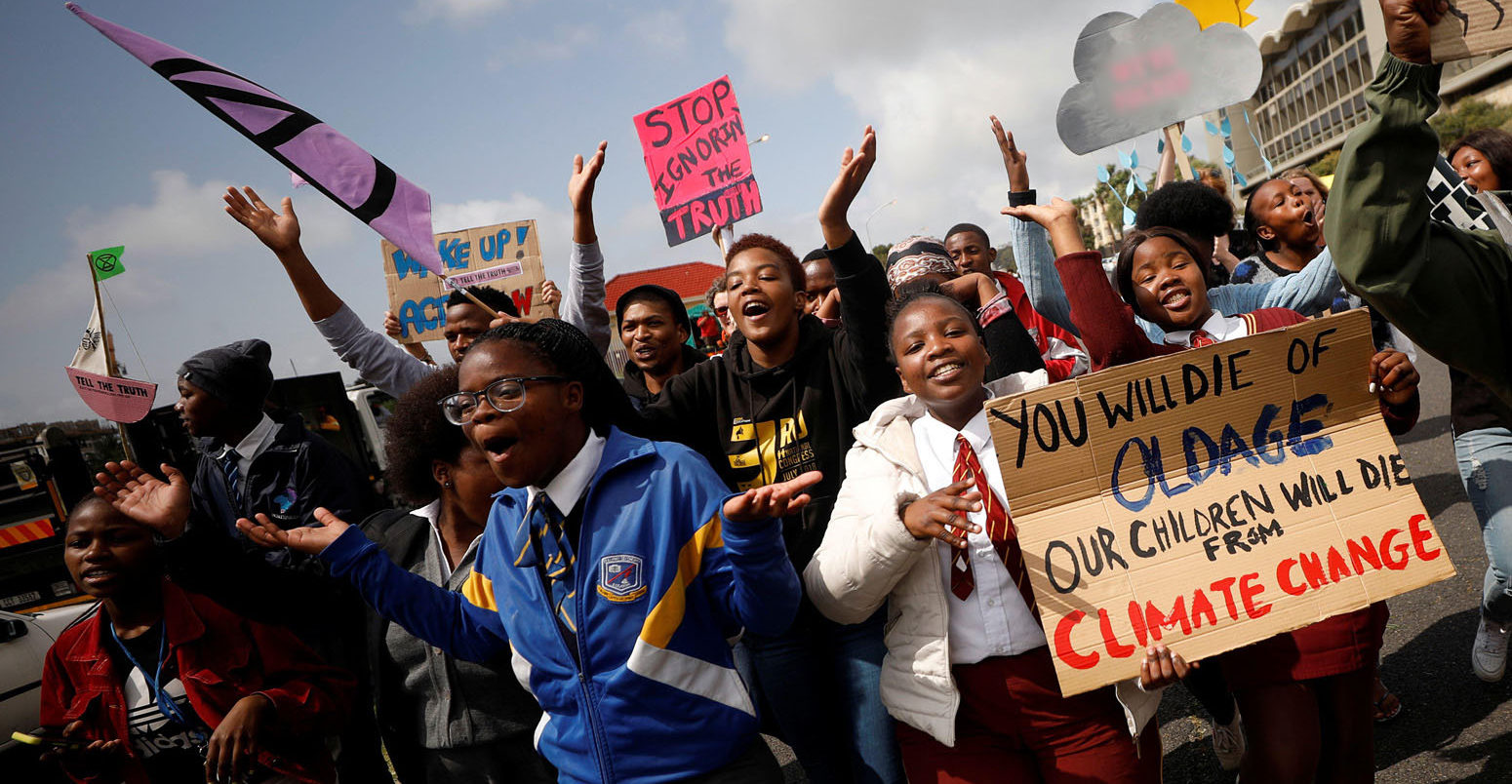
When hurricanes, floods or droughts strike, all too often those hit hardest are poor and marginalised communities who bear little responsibility for climate change.
This is the central argument of “climate justice” – a reshaping of climate action from a technical effort to cut emissions into an approach that also addresses human rights and social inequality.
As industrialised nations and corporations have amassed wealth by burning fossil fuels, many also argue that a “just” outcome would involve them redistributing more of this wealth towards those having to deal with the consequences.
Pioneered by activists from the global south in response to the threats facing their homelands, today the term “climate justice” is widely used by researchers, NGOs and politicians seeking to address related injustices throughout society.
In this Q&A, Carbon Brief explores the history of climate justice, examining why the impacts of global warming are not borne equally and how the concept has influenced international politics, activism and courtrooms in recent years.
- How has the concept of climate justice been developed?
- What does the climate justice movement want?
- How does climate change affect people unequally?
- How has climate justice shaped international negotiations?
- How has it influenced climate activism and politics?
- How has it influenced climate litigation?
How has the concept of climate justice been developed?
Climate justice has emerged from the idea that historical responsibility for climate change lies with wealthy and powerful people – and yet it disproportionately impacts the poorest and most vulnerable.
- Analysis: Which countries are historically responsible for climate change?
- Analysis: The lack of diversity in climate-science research
- Climate justice: The challenge of achieving a ‘just transition’ in agriculture
- Experts: Why does ‘climate justice’ matter?
- Researchers: The barriers to climate science in the global south
- Guest post: An Indigenous peoples’ approach to climate justice
It has primarily been used to frame the contrast between industrialised nations that have been burning large volumes of fossil fuels freely for centuries and the poorer regions that are most susceptible to rising temperature.
Besides nations or governments, the term has also been employed to target the fossil fuel companies themselves, which have generated large profits while actively downplaying the impact of greenhouse gas emissions and blocking climate action.
However, the scope of climate justice is broad and, since its popularisation in the 1990s, the term has come to encompass the unequal distribution of impacts on a variety of groups, including Indigenous people, people of colour, women and disabled people.
It has also been used to describe the intergenerational injustice of older generations benefiting from fossil fuels and leaving young people to deal with the consequences.
Some refer to the “triple injustice” of climate change, with those affected the most, but contributing the least, sometimes also facing an additional burden from responses to global warming that worsen their situations further.
According to Asad Rehman, executive director of anti-poverty NGO War on Want, the concept of climate justice has largely been developed by activists from the global south who have argued that:
“Fixing the climate is only possible if we also fix all of the other inequalities that exist because not only does climate reinforce all those things, but it also amplifies them – and it’s an expression of those things.”
Mohamed Adow from thinktank Power Shift Africa tells Carbon Brief that climate justice is “an extension of the struggles of [global] southern, Indigenous and local communities for land, resources, sovereignty and anticolonialism”.
Today, the message can be heard from the waves of climate protesters who take to streets around the world chanting: “What do we want? Climate justice. When do we want it? Now!” The timeline below lays out some of the key moments in the ascent of climate justice as a political idea and a rallying cry for activists.
A UN Research Institute for Social Development (UNRISD) paper describes the “global climate justice movement” as a loose merger between three entities: the environmental justice movement, the global justice or anti-globalisation movement, and a group of radical international NGOs involved in United Nations (UN) climate talks.
The concept of “environmental justice” is often traced to the early 1980s in the US, when black protesters opposed the dumping of toxic chemicals in their communities, although its roots stretch back further to the civil rights activism of the 1960s.
This movement was led by people of colour outside of the predominantly white environmental establishment in the US who wanted to draw attention to the fact that their communities were being hit hardest by pollution.
Such “environmental racism” has been summarised by “father of environmental justice” Dr Robert Bullard of Texas Southern University:
“Whether by conscious design or institutional neglect, communities of colour in urban ghettos, in rural ‘poverty pockets’, or on economically impoverished Native-American reservations face some of the worst environmental devastation in the nation.”
These concerns were formalised at the First National People of Color Environmental Leadership Summit in 1991, where attendees set out 17 principles of environmental justice.
They reflected Indigenous perceptions of the environment, with a first principle to affirm “the sacredness of Mother Earth, ecological unity and the interdependence of all species, and the right to be free from ecological destruction”. However, there was no mention of climate change.
In the years that followed, organisations with an anticapitalist, global justice perspective on issues such as debt, trade and globalisation began taking a greater interest in climate change. Their work in this area helped reframe the issue as something affecting people rather than simply an “environmental” problem.
The environmental justice movement came from communities that historically bore the brunt of hosting waste sites. When a predominantly black county in NC (Warren County) protested a toxic waste landfill, it galvanized the nation to talk about environmental racism. pic.twitter.com/HYBQwN0dHS
— NC DNCR (@ncculture) December 18, 2020
Meanwhile, some civil society groups and global south nations involved in UN international climate negotiations started calling for richer countries to shoulder their historical responsibility for climate change and repay their “climate debts” to the global south.
In 1999, the NGO CorpWatch released a report titled, “Greenhouse Gangsters vs. Climate Justice”, an early use of the term, which took aim at the fossil fuel industry and stated that climate change “may well be the largest environmental justice issue of all time”.
The world’s first-ever Climate Justice Summit came soon after in 2000, organised by CorpWatch and held at the same time as the COP6 negotiations in The Hague. The summit resulted in an action statement saying:
“We affirm that climate change is a rights issue. It affects our livelihoods, our health, our children and our natural resources. We will build alliances across states and borders to oppose climate change inducing patterns and advocate for and practice sustainable development.”
Two years later, an international coalition of social and environmental organisations released the 27 Bali Principles of Climate Justice to “redefine climate change from a human rights and environmental justice perspective”. These global principles used the US-centred environmental justice principles as a blueprint.
All of this came to a head at the COP15 climate summit in Copenhagen in 2009, which saw a mass mobilisation of climate justice activists and calls from global south leaders for recognition of wealthy nations’ responsibility for climate change. (See: How has climate justice shaped international negotiations?)
The chart below shows how mentions of “climate justice” in the global media had an initial surge in the year of COP15 and have more than doubled in volume since 2018.
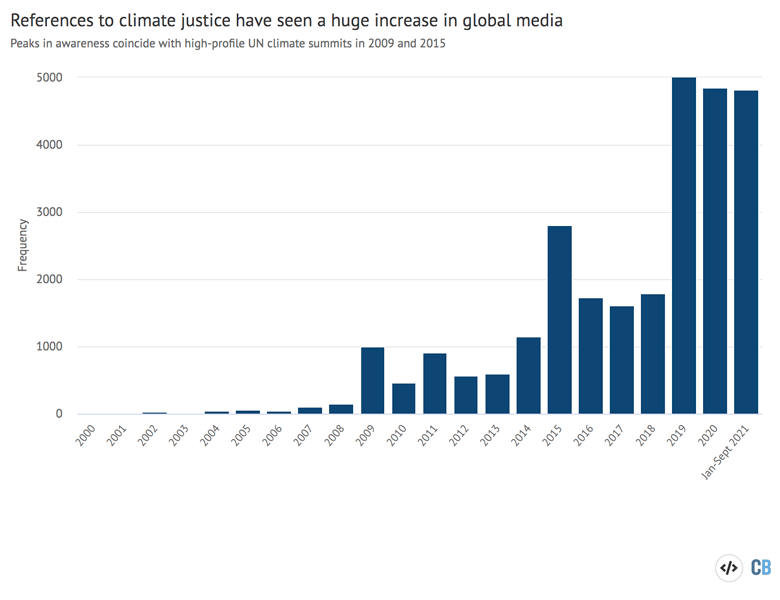
As these ideas have become more widespread, “elite” NGOs, such as the Mary Robinson Foundation, have tried to bridge the gap between the political establishment and the more radical demands of grassroots activists.
Robinson herself, a former UN high commissioner for human rights, has described climate change as “probably the greatest human rights challenge of the 21st century”.
Meanwhile, climate-justice ideas have also been developed by academics – although, according to Dr Michael Mikulewicz, a critical geographer at the Centre for Climate Justice at Glasgow Caledonian University, this has largely taken place in isolation from activism.
He tells Carbon Brief that early work in this area was largely theoretical and philosophical, focusing on “climate ethics” and who was responsible for global warming.
However, over the past 15 years the field has “grown exponentially”, with geographers, economists, anthropologists and sociologists all getting involved, he adds.
This growth can be seen in the chart below, which shows academic publications mentioning “climate justice” captured on the Web of Science database since 2000.
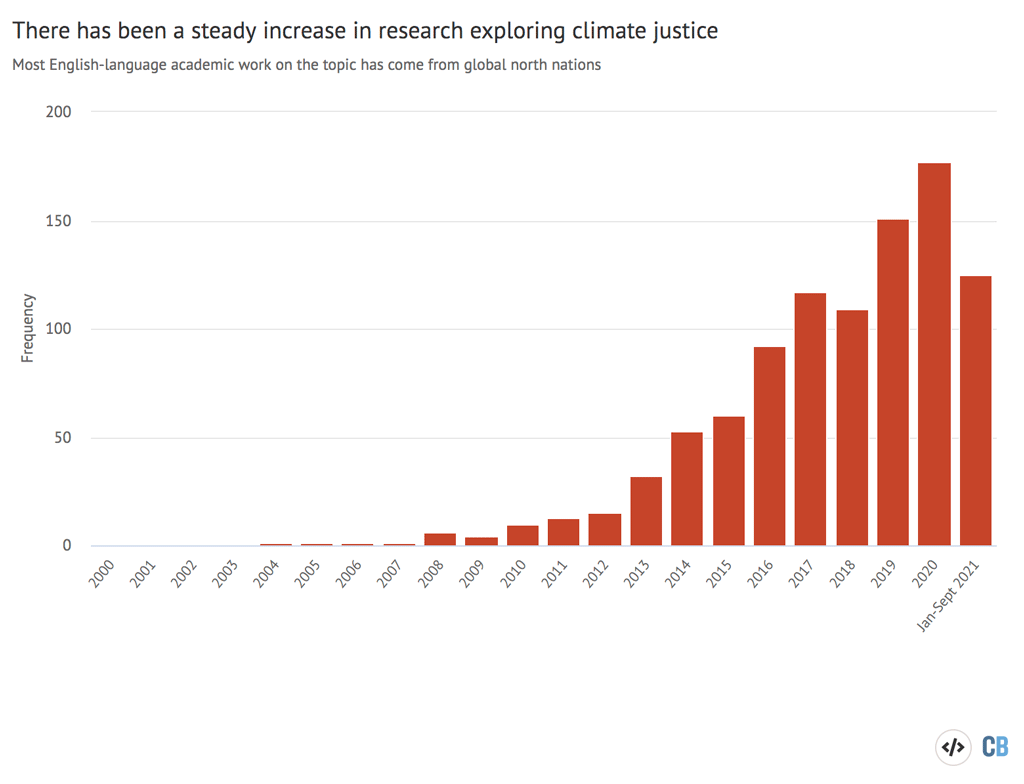
In contrast to the many global south-led climate justice movements, the “theoretical foundations of climate justice are quite northern-led,” according to Dr Shilpi Srivastava from the Institute of Development Studies. Of the 968 papers referencing “climate justice” Carbon Brief found on Web of Science, just 148 featured contributions from global south institutions.
The first mention of climate justice in academic literature has been identified as a 1989 book on intergenerational inequality by US environmental lawyer Dr Edith Brown Weiss of Georgetown University.
In fact, the text in question originally came from a paper Weiss had presented at a conference on “developing policies for responding to future climatic change” in 1987. In its introduction, she stated:
“Global climate change induced partly by human activities raises serious issues of justice between the present generation and future generations, and between communities within future generations. In using the planet’s resources for our own benefit, we may pass many of the costs to future generations in the form of climate change and the need to adapt to such change.”
However, as Weiss tells Carbon Brief, the ideas underpinning this work go back even further, with her own studies of the international legal and political implications of climate modification dating back to 1973.
Concerns about intergenerational injustices, demonstrated more recently by the Fridays for Future protests, are one of the “four pillars of climate justice” identified by Srivastava and her colleagues in a recent paper. The others are:
- Distributional – how the costs and benefits of climate change and action are shared.
- Procedural – ensuring the processes for making decisions about the impacts of and responses to climate change are fair, accountable and transparent.
- Recognition – Recognising differences between groups in how they experience climate change and their right to express these differences.
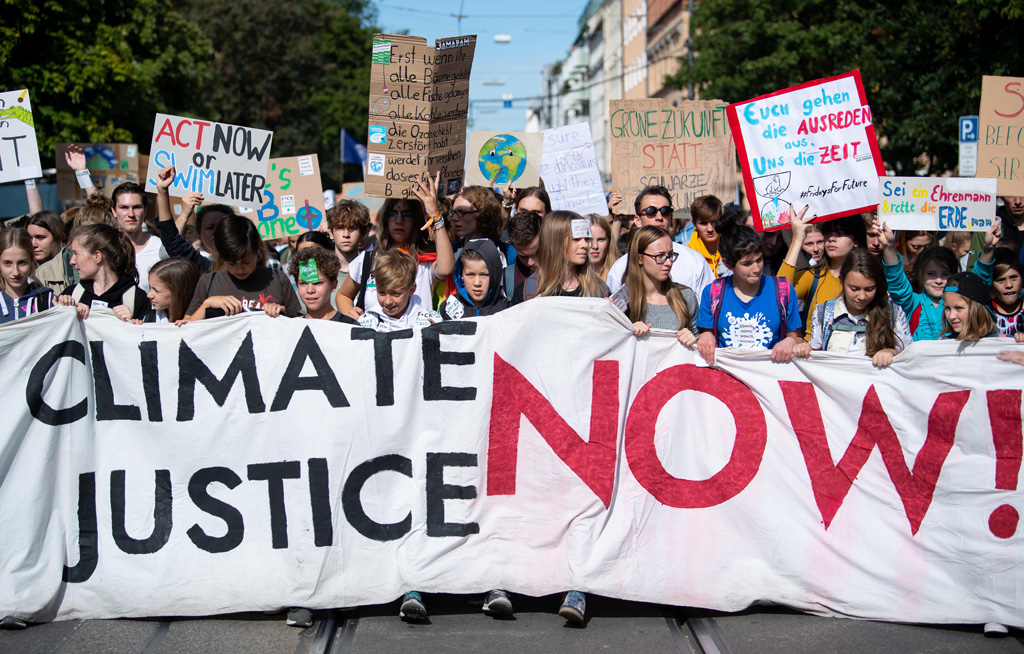
Srivastava tells Carbon Brief that while the distributive aspects of climate justice have gained some traction – for example, the idea that vulnerable nations should be helped to adapt to climate change – other aspects, such as inclusivity, have been less prominent:
“Whose voices are dominating the agenda and ‘solutions’?…There is a risk that climate justice might be (mis)appropriated as a trope unless we remain vigilant and take concrete steps towards including the voices of those who are most vulnerable to climate change impacts.”
There are also concerns in the activist community that, as climate-justice discourse has proliferated, the concept has been stripped of its core demands for economic overhaul and redistribution of wealth, captured in the slogan “system change, not climate change”.
However, Dr Saleemul Huq, director of the International Centre for Climate Change and Development (ICCCAD) in Dhaka, Bangladesh, says that, in his view, the world is entering a “third age” of climate change response in which it is viewed predominantly as a moral problem:
“It’s a matter of manifest injustice and that’s easily recognisable by everyone all over the world, including school kids who come out every Friday…They don’t really need to understand greenhouse gases, they don’t need to understand UNFCCC [UN Framework Convention on Climate Change] and IPCC [Intergovernmental Panel on Climate Change] and all that stuff, they can understand the fundamental inhumanity of causing damage to poor people by their lifestyle”.”
What does the climate justice movement want?
There has been considerable debate about what constitutes a “just” approach to climate action, reflecting the diversity of the people and groups involved.
Over the years, dozens of declarations and manifestos have laid out the priorities of various climate justice groups, one recent example being the “people’s demands” of the Global Campaign to Demand Climate Justice.
Many common themes have emerged from these documents, including a focus on Indigenous rights, women’s rights and the rights of future generations.
Below, Carbon Brief unpacks some of the central concepts that have solidified over the years and what they mean for international climate politics.
‘Fair shares’ of emissions
Fossil fuel use and greenhouse gas emissions have been skewed over the course of history towards a small number of relatively wealthy nations.
The geographical inequality of emissions can be seen in the chart below, with the “high-income” countries identified by the World Bank shown in blue.
In total, these countries are responsible for 44% of cumulative CO2 emissions from fossil fuels, land use and forestry since pre-industrial times, as the blue area on the chart below shows. This is particularly notable given they are home to just 14% of the global population today.
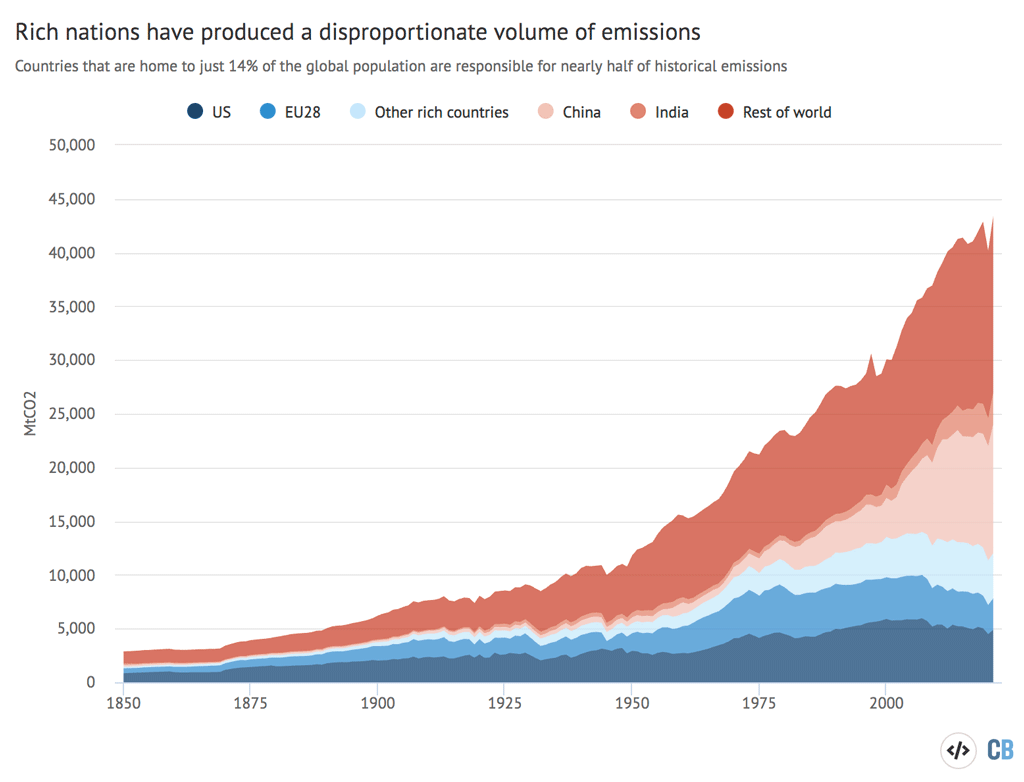
A key demand of the climate justice movement is for rich countries to recognise their historical responsibility for emissions and respond with dramatic cuts to limit warming to 1.5C, in line with the most ambitious target of the Paris Agreement.
This demand is also made in light of the greater capacity such nations have to spend money on decarbonising.
The “carbon budget” – the remaining emissions that can be released before any given temperature is breached – has emerged as a central concept in climate science and policy over the past decade.
There is only around 460bn tonnes of carbon dioxide (GtCO2) – or 11.5 years of 2020-level emissions – of the global carbon budget remaining beyond 1 January 2021 before being committed to 1.5C of warming.
Dividing the carbon budget up “fairly” is seen as an issue of climate justice. However, as Prof Niklas Höhne of the NewClimate Institute tells Carbon Brief, “there are wide differences in the interpretation of what’s fair.”
Poorer nations, such as India, have argued that they should be allowed to use more of the remaining “atmospheric space” or “carbon space” – essentially the remaining budget – to help them develop, as rich nations have used more than their fair share. (Others argue that cheap low-carbon technologies mean such nations could “leapfrog” fossil-fuelled development in favour of technologies such as renewables power.)
These debates have been complicated by the rapid growth of some nations, particularly China, where emissions have risen significantly in the three decades since the UNFCCC divided the world into industrialised or “economies in transition” Annex I and “mostly developing” non-Annex I nations.
Despite their significant contribution today, these countries have argued that they do not share the same responsibility as nations that have maintained high emissions for centuries.
For India, in particular, its high emissions today mask the fact that its per-capita emissions remain low and millions still live below the poverty line.
This position was outlined at the COP15 summit in 2009 by Chinese diplomat Su Wei, who criticised the commitments made by the US, EU and Japan, while pointing to developing countries’ lack of historical responsibility.
The opposing view was voiced by US diplomat Todd Stern, who told reporters: “Emissions are emissions. You’ve just got to do the math. It’s not a matter of politics or morality.”
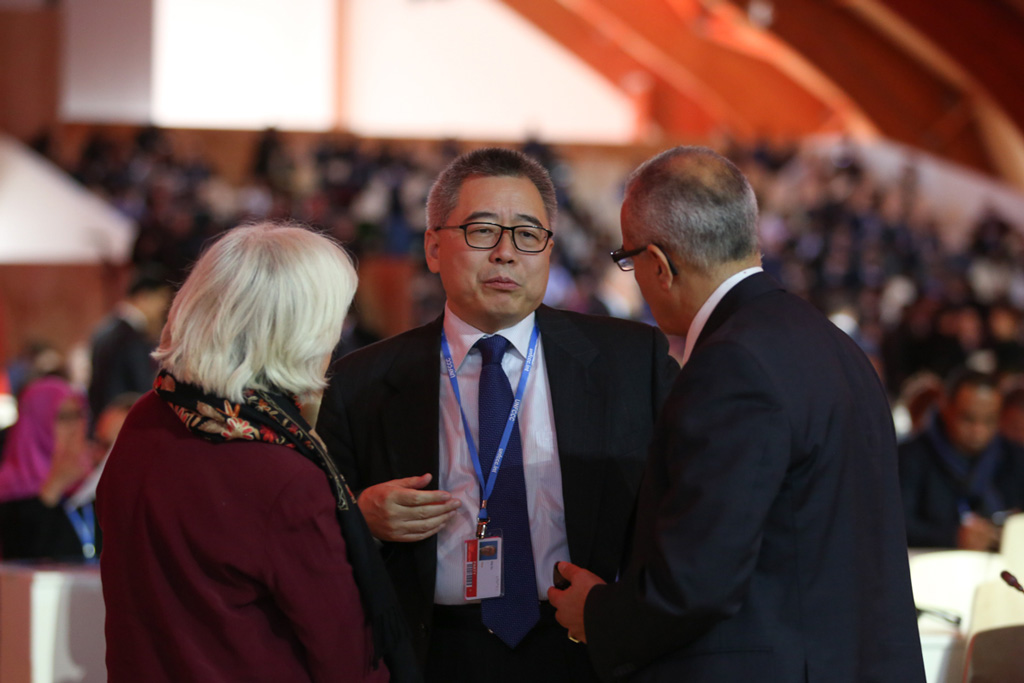
While the UNFCCC has always recognised nations’ “common but differentiated responsibilities and respective capabilities” to address climate change, some have argued that this principle has been “watered down” under pressure from richer nations. (See: How has climate justice shaped international negotiations?).
The Paris Agreement sidesteps the contentious issue of what makes a “fair share”, but nevertheless all parties under it must come forward with climate pledges and justify why they are fair and reflect their “‘highest possible ambition”.
As it stands, these nationally determined contributions (NDCs) – even if met in full – are set collectively to breach the Paris temperature targets and result in warming of an estimated 2.4C.
One issue is that, as a recent paper puts it, “diverse perspectives on fairness have resulted in a wide range of self-serving calculations”. Prof Lavanya Rajamani, an international environmental law expert at the University of Oxford, who led the study, tells Carbon Brief:
“If every country had to extrapolate from their criteria what it would mean if they were extended to the rest of the world, the unfairness of their fair share would become very clear.”
The analysis concluded that many fairness justifications used in NDCs, such as allocating emissions cuts where it is cheapest to do so, relied on arguments that were not supported by principles of international law. Sticking to these legal principles would tend to require deeper cuts from developed countries, the paper found.
Many groups calling for climate justice have argued that rich nations should be the ones bridging the gap to meet Paris Agreement targets.
Responding to a perceived lack of equity analysis within the UN system, in 2015 a large group of NGOs set up the Civil Society Review, which has produced a series of reports highlighting the gaps between “fair shares” and actual commitments.
In its 2018 report, the review stated that the “rhetorical insistence that ‘we all have to do more’” would not be enough to achieve the Paris targets:
“This misleading – or, at best, incomplete – framing of the situation is part of the problem…It is overwhelmingly wealthy industrialised countries which are failing to make their fair share of the global effort. And that fact carries profound political implications.”
This assessment was based on work by the Climate Equity Reference Project (CERP), which was set up by thinktanks EcoEquity and the Stockholm Environment Institute to define “fair shares” based on “core equity principles of the UNFCCC”.
Using the same methodology, which prioritises nations’ historical responsibility and financial capacity to act, the US branch of Climate Action Network (CAN) has called for a “fair share” target of cutting US emissions by 195% below 2005 levels by 2030. NGOs in the UK have called for a similar reduction target of 200% below 1990 levels.
The current domestic targets for the US and the UK are 50-52% and 68%, respectively.
In both cases, national “fair shares” far exceed their emissions today, meaning that to achieve equitable outcomes the countries would be required to contribute significant financial support to ensure cuts in other countries. (See: Climate debt and climate finance.)
By contrast, as the chart below from 2018 shows, the CERP approach suggests that the global south, including large emerging economies, have been taking on their fair shares. (The black horizontal lines show the amount of emissions reductions per capita in 2030, as implied by the nation’s NDC at the time, compared to the coloured lines which show “fair” reductions under different equity settings.)
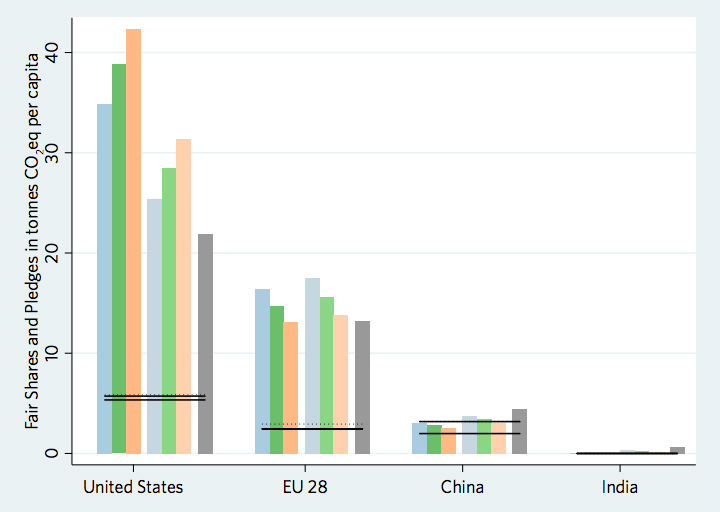
The Civil Society Review notes that despite China and India meeting its definition of fair shares, they would still need to undertake far greater emissions cuts in the future, supported by international finance, or the 1.5C goal will be “quite impossible”.
However, it notes that it is “hard to see how this could possibly happen while the richer countries continue to expect a free ride”.
Other attempts to calculate “fair shares” place greater responsibility on global south nations.
For example, in its most recent update, Climate Action Tracker (CAT) – an independent analysis of climate pledges produced by two research organisations – deemed both India and China’s commitments to be “highly insufficient” based on their “fair shares”.
CAT has developed its own methodology based on a review of dozens of papers examining “fair shares”, which gives equal weight to equity considerations beyond historical responsibility and capacity, such as the relative cost-effectiveness of climate action.
Höhne, who leads CAT, tells Carbon Brief that while it is “super clear” that industrialised countries need to support other nations financially:
“…the closer we come to the 1.5C limit, the less relevant is the question of what is a fair share because we simply have to reduce emissions drastically. Everybody has to do it.”
Some climate activists, including Greta Thunberg, have suggested that a fairer way of assessing emissions would be to look at consumption rather than territorial emissions.
They argue that, otherwise, wealthy nations get a free pass for using emissions-intensive products that are made in countries such as China.
On the other hand, some argue in favour of handing responsibility for emissions to those that produce the fossil fuel that created them – for example, oil companies or exporters, such as Australia.
While the international reporting system is based on territorial emissions, even splitting up emissions by country could be viewed as an imperfect way of deciding fairness, given the large financial and emissions-related inequality that exists in many societies.
Dr Saleemul Huq, who is based at ICCCAD, says this “rich people vs. poor people” framing is important when discussing climate justice.
“Those of us who produce more than our fair share of emissions – and I include myself in that group – we owe something to the victims of our pollution.”
This is recognised in the Bali Principles of Climate Justice, developed by NGOs in 2002, which note that “unsustainable consumption exists primarily in the north, but also among elites within the south”. Indian journalist Praful Bidwai has described the focus on national per capita emissions as “a shield that enables India’s elite to hide behind the poor”.
The UNEP chart below shows the vast inequality in emissions output between the world’s rich and poor. Its analysis suggests that a top 1% earner – someone earning over $109,000 (£80,000) per year – will need to cut their personal emissions by 97% to reach a “fair share” level by 2030, in line with the 1.5C target, indicated by the purple line.
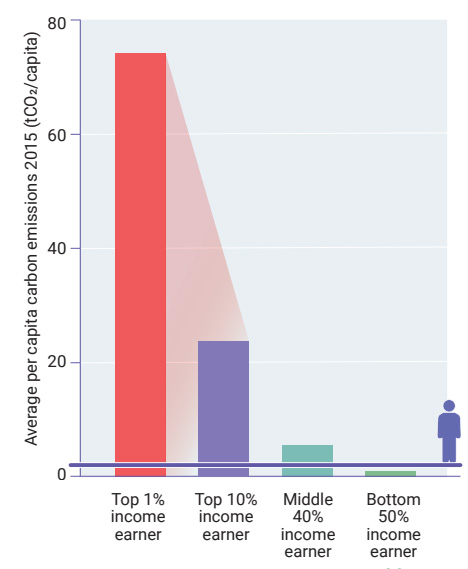
Analysis conducted for Oxfam found that, in 2015, around half the emissions of the richest 10% – with an income of over $38,000 (£28,000) – were associated with people in the EU and the US. Around a fifth of these emissions were produced by people in China and India.
The charity has called for policies to curb the emissions of the wealthy, including higher taxes and bans on carbon-intensive luxury items and activities, such as frequent flights.
On an individual level, research suggests that the perceived fairness of a climate policy plays a big role in deciding whether people support it or not. However, once again, people can have very different perceptions of what “fair” outcomes would be.
Is fairness really that basic a value? Dependent on one’s value dispositions, people define it as ‘equality’, ‘proportionality’ (not cheating or taking more than you worked for), or both. Here’s some recent data: pic.twitter.com/Q7Xg1MPKVw
— Kris De Meyer (@kris8dm) September 24, 2021
Climate debt and climate finance
Significant costs are likely to fall on nations that lack funds to spend on, say, erecting wind turbines or building flood defences. Much of the climate-justice narrative centres around the need for wealthy countries to pay for these things.
An early rallying point for the climate-justice movement was the idea that industrialised nations – as well as high-polluting corporations – owed the global south a “climate debt”.
This was an extension of the concept of “ecological debt”, an idea that emerged in the early 1990s and was described by Ecuadorian NGO Accion Ecologica as:
“The debt accumulated by the northern industrial countries towards the countries and peoples of the south on account of resource plundering, environmental damages, and the free occupation of environmental space to deposit wastes, such as greenhouse gases.”
In climate negotiations this concept was initially pushed by global south nations as well as NGOs, with a group led by Bolivia submitting a document at the COP15 summit in 2009 stating that:
“The scale and timing of emission reductions by Annex I [industrialised] countries must be sufficient to ensure that developed countries’ historical debt for their excessive past consumption of environmental space, and their continuing excessive per-capita emissions, is fully repaid to developing countries.”
At the talks, Bolivian negotiator Angelica Navarro made it clear that in practice this meant both significant emissions cuts and also a transfer of finance and technology from richer countries to poorer ones. She told Democracy Now:
“What we are asking is repayment…We are not begging for aid. We want developed countries to comply with their obligation and pay their debt.”
In short, this would require massive redistribution of wealth between countries to fund both climate mitigation and adaptation. Some academics and politicians have framed it as “climate reparations”, emphasising the links to histories of colonialism, slavery and exploitation.
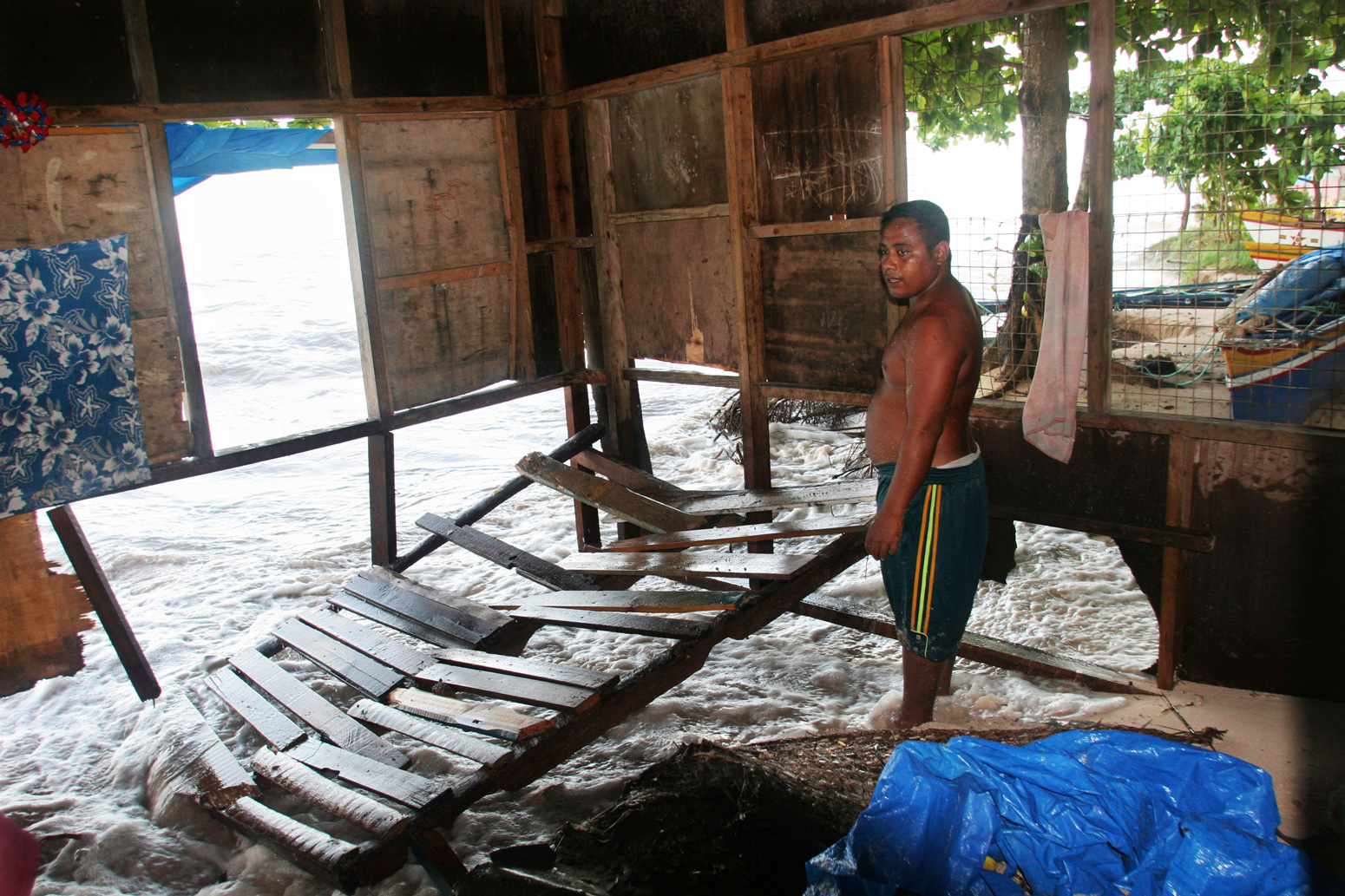
From the outset, industrialised nations have resisted efforts to characterise their historical responsibility in this way. Their position was summarised at the COP15 by the US chief climate negotiator Todd Stern:
“I actually completely reject the notion of a debt or reparations or anything of the like…Let’s just be mindful of the fact [that] for most of the 200 years since the Industrial Revolution, people were blissfully ignorant of the fact that emissions cause the greenhouse effect. It’s a relatively recent phenomenon. It’s the wrong way to look at this. We absolutely recognise our historical role in putting emissions in the atmosphere that are there now. But the sense of guilt or culpability or reparations, I categorically reject that.”
This does not mean that money is off the table in climate talks. Climate finance has always been part of negotiations, albeit framed in a way that is more palatable for wealthier nations.
In 2009, industrialised – or Annex II – countries agreed to provide funds rising to $100bn per year by 2020 to support climate action in poorer nations. The target was reportedly devised by Hillary Clinton, then secretary of state to US president Barack Obama, in the heat of COP15.
Since then, the figure has become a touchpoint in climate justice conversations, with campaigners urging governments to honour their commitments.
The chart below shows the most recent available climate finance figures from the Organisation for Economic Co-operation and Development (OECD), suggesting the total reached around $80bn in 2019. While a figure for 2020 is not yet included, an independent analysis for the UN at the end of 2020 concluded that “the only realistic scenarios are those in which the $100bn target is not reached this year”.
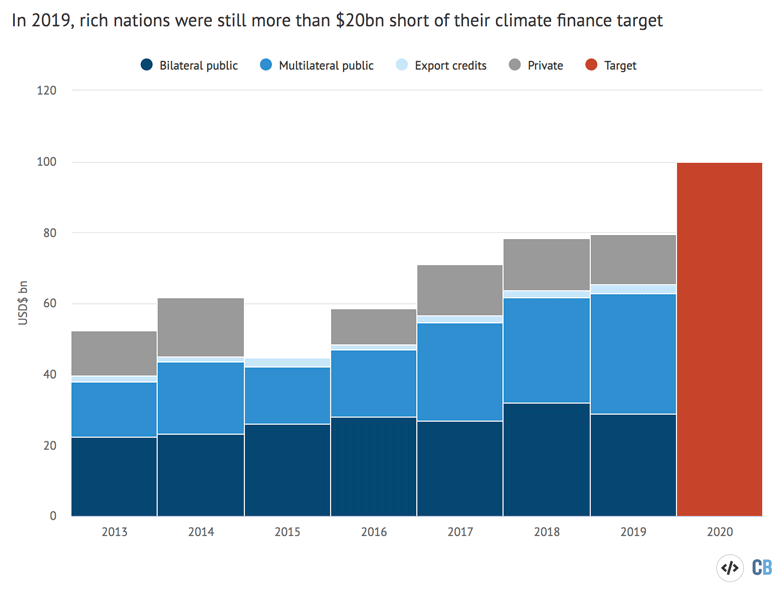
This is a problem for the future of climate negotiations, according to Dr Saleemul Huq of ICCCAD. He tells Carbon Brief:
“If they don’t cough up the money, COP26 is already a failure…If you make a pledge and don’t meet it, that makes the discussion one in bad faith.”
Despite the importance of this target, many have pointed out that $100bn does not match the true needs of the global south.
Dr Keston Perry, a political economist and assistant professor of Africana studies at Williams College, tells Carbon Brief that the $100bn target was agreed in the context of “uneven power dynamics at the UN”:
“It’s not really a scientific amount, it came about as a result of negotiations in which the industrialised countries are really pulling the strings.”
There is also the question about the form that climate finance takes. Climate justice campaigners would like to see money and technology provided with “no strings attached”, outside of institutions such as the World Bank, the International Monetary Fund (IMF) and development aid programmes, where wealthy countries can influence how it is distributed.
The Green Climate Fund, established to help deliver the $100bn target, was seen as a relatively equitable way of distributing finance, as its board includes equal representation from “developed” and “developing” countries, climate justice campaigners tell Carbon Brief. However, only a fraction of total climate finance flows through the fund.
Much of the money provided as climate finance falls short of climate justice campaigners’ hopes, as Dr Michael Mikulewicz of Glasgow Caledonian University tells Carbon Brief:
“A lot of development aid has been relabelled as climate aid and in many cases double counted as both, so there is no additional money in many cases…there really isn’t much appetite for anything like a direct transfer of wealth to the global south.”
Most climate finance also comes in the form of loans, with the share of total money distributed in this way to different groups of nations indicated by the blue bars in the chart below. This is “making countries that are most marginalised more indebted to global north countries,” says Perry.
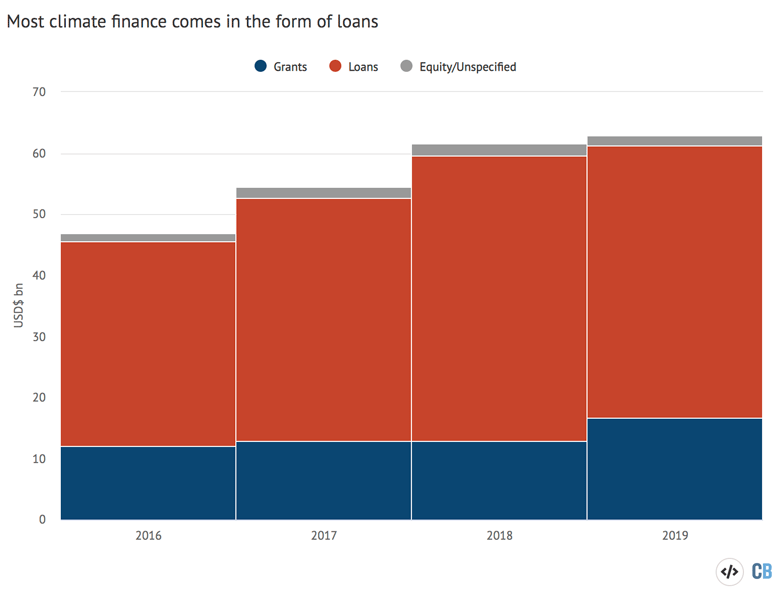
Oxfam estimates that of the roughly $60bn in public climate finance reported by developed countries in 2017-2018, the “true value” is closer to $19-22.5bn per year once loan repayments, interest and “other forms of overreporting” are discounted.
Angelique Pouponneau, a former adviser for small island states on climate finance who runs the Seychelles’ Conservation and Climate Adaptation Trust, says that more radical demands for compensation or reparations simply do not attract consensus agreement in UN negotiations:
“This leaves countries with financing options that are in the form of development aid or loans and, if you ask me if that is fair, I would say, no, it is not. However, I think the thinking about climate justice and its link to climate finance have to go further than the criticism that it is not fair.”
Instead, she asks if other avenues, such as climate litigation, could yield more desirable outcomes in international arenas.
There are also justice-based critiques of how and where climate finance is spent. Many countries will need to spend huge sums of money on adapting to climate impacts, yet, as it stands, the majority of climate finance goes towards mitigation – indicated by the purple bars below.
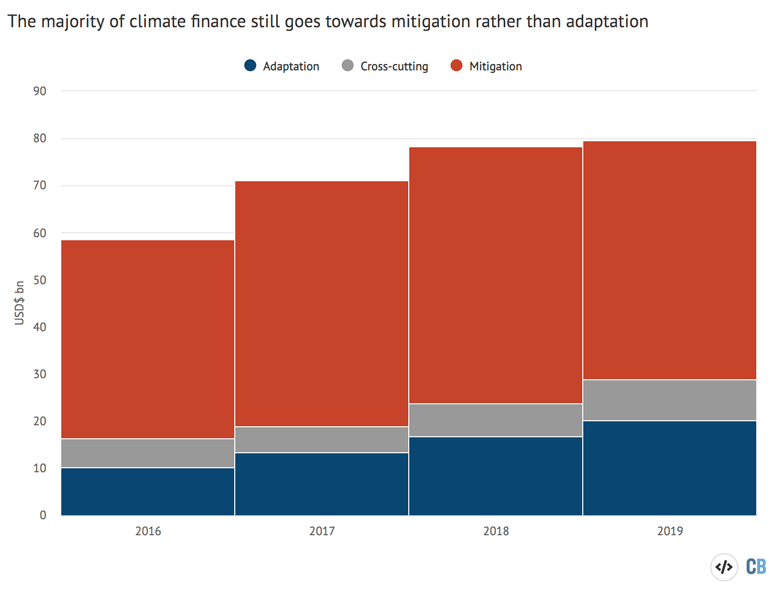
For the first decade of climate negotiations, there was little discussion of adaptation finance at COPs, with talks focusing largely on cutting emissions.
There were references to such funding in the text of the UNFCCC, the world’s first climate treaty, in 1992. However, acknowledging it was seen as an “implicit acceptance of responsibility for causing climate change,” according to one paper, which adds that vulnerable nations reportedly did not want to derail mitigation talks with conversations about adaptation.
However, this began to change in the early 2000s as warnings from the IPCC about the inevitable need to adapt became starker.
With the UNEP adaptation gap report suggesting that adaptation costs “in developing countries alone” could reach $140-300bn in 2030, there are widespread calls for at least half of climate finance to go towards adaptation. This echoes language in the Paris Agreement urging a “balance between adaptation and mitigation” finance.
Finally, while it is generally understood that the poorest nations will be most in need of support to tackle climate change, they are far from the main recipients of finance, as the chart below shows.
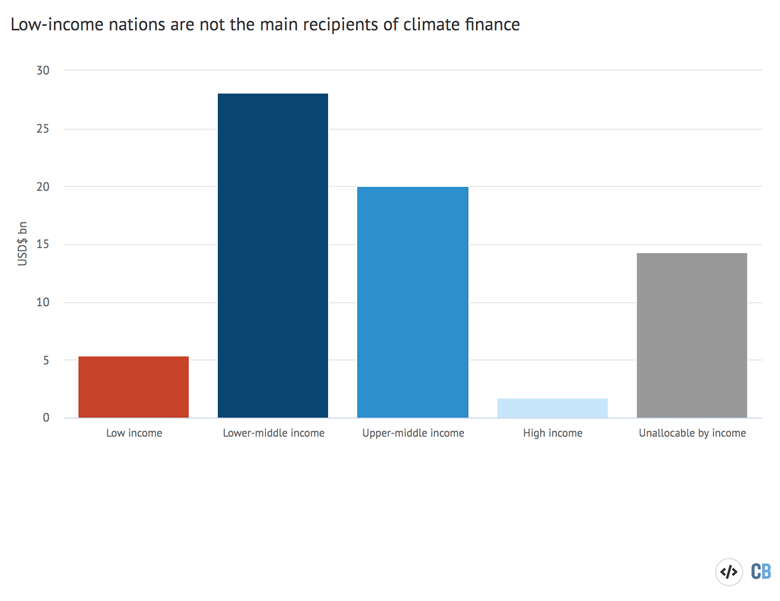
Moreover, according to Oxfam, only around 3% of funds from 2017-2018 went to small island developing states (SIDS). This is disproportionate to their size, given that SIDS are home to less than 1% of the global population, but the charity notes that these nations “face the gravest threat from climate change and have the fewest resources to cope”.
“By this measure alone, there is a disconnect between the global north’s rhetoric and their actual support to SIDS,” Dr Janine Felson, climate justice lead negotiator for the Alliance of Small Island States (AOSIS) tells Carbon Brief.
Pouponneau says this is, in part, because many of these nations are classed as upper-middle or high-income countries, making them less eligible for overseas development assistance despite their high vulnerability to climate change.
Separately, the concept of “loss and damage” has been developed in a bid to generate support for unavoidable or unpredictable climate impacts that cannot be adapted to.
Poorer nations in the UNFCCC process have continued to advocate for some kind of compensation fund for victims of climate change, despite the Paris Agreement explicitly stating it “does not involve or provide a basis for any liability or compensation”.
Richer nations, notably the US, have blocked these efforts and largely restricted the talks to discussions of insurance schemes.
While there has been some progress in discussions on this topic over the past decade, what is lacking is a new pot of funding. Civil society estimates have placed the costs of loss and damage at $300-700bn by 2030, rising to $1.2tn per year by 2060.
Harjeet Singh, a senior adviser on climate impacts at CAN International, tells Carbon Brief that it is clear why wealthy nations want to avoid admitting responsibility:
“The numbers are massive and rich countries and corporations know that they are going to be blamed and that’s why they have always been scared of recognising loss and damage and the related compensation and liability provision.”
No ‘false solutions’
Climate-justice activists oppose what they see as “false solutions” to climate change, namely technologies and policies that may cut emissions, but run counter to the wider cause of justice.
This is outlined in the Bali Principles of Climate Justice which state that “market-based mechanisms and technological ‘fixes’ currently being promoted by transnational corporations are false solutions and are exacerbating the problem”.
Prof Olúfẹ́mi Táíwò, a philosopher at Georgetown University who has addressed issues of environmental justice, says that, in his view, this is born out of a realistic understanding of the limits of technological innovation:
“I take it that the ‘false solutions’ rhetoric is an attempt to get us to take our problems seriously. We’re not going to ‘one weird trick’ our way out of the climate crisis because it isn’t made of one simple, isolable problem.”
The controversial concept of geoengineering is among these “false solutions”, but widely used technologies have also been given the label, including nuclear power, large hydropower dams and biofuels. Critiques of these energy sources tend to focus on the resulting waste and land-rights disputes, as well as their impact on communities.
There are also concerns that the injustice of climate change could take on another dimension if the costs of addressing it predominantly harm poor and vulnerable people.
A key battleground over the years has been the push for carbon markets, a measure supported by many large, global north NGOs, but generally opposed by grassroots movements.
“We don’t believe in carbon markets. We think that is a dangerous distraction,” Meena Raman, legal adviser and senior researcher at Third World Network in Malaysia, tells Carbon Brief.
Climate justice groups say that carbon trading allows nations and companies in the global north to continue producing greenhouse gases while relying on the global south to offset their emissions.
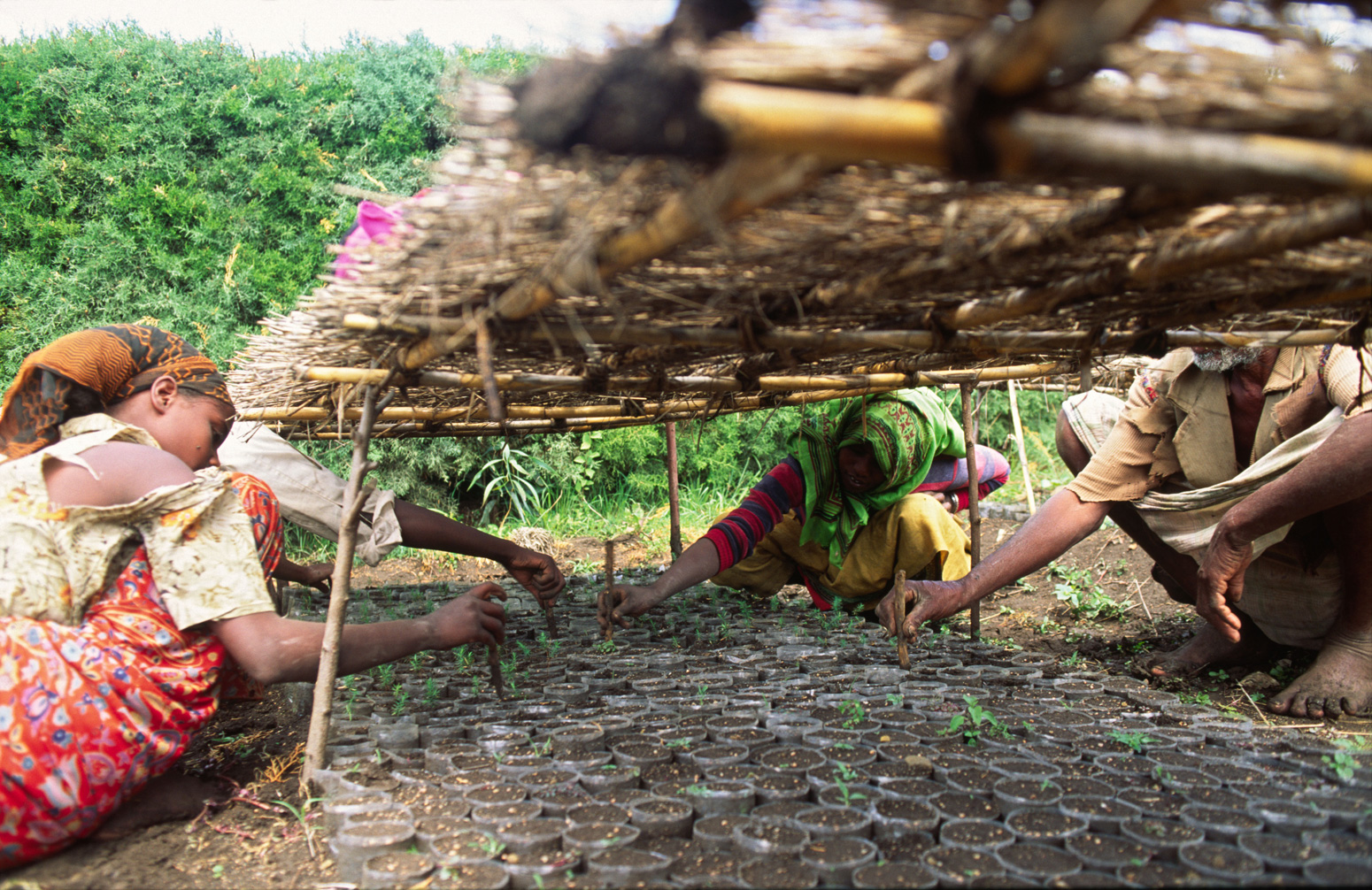
An example is the UN’s Reducing Emissions from Deforestation and Forest Degradation (REDD) programme, which Indigenous groups say threatens the land rights of forest-dependent communities, while adding little climate benefit.
Criticisms were levelled at the Kyoto Protocol after the US pushed for the inclusion of a carbon market in the agreement.
The protocol contains a Clean Development Mechanism (CDM), which aimed to finance emissions reductions in the global south, but has been accused of generating “hot air” – cuts that would have happened anyway.
Critics have also linked CDM projects with human-rights violations, particularly involving Indigenous people, owing to their impact on land and livelihoods.
Similar debates are still ongoing around the much-delayed Article 6 rules of the Paris Agreement. So far, nations have been unable to reach an agreement on these rules.
In 2004, academics and NGOs signed the Durban Declaration on Carbon Trading, which criticised the way in which markets turned “the earth’s carbon-cycling capacity into property to be bought or sold in a global market”. This became a key foundational text for climate justice groups.
Such concerns are linked to wider criticisms of carbon removal – whether using carbon capture and storage (CCS) technology or mass tree-planting – as Dr Wim Carton, who researches the politics of climate mitigation at Lund University, tells Carbon Brief:
“Carbon removal is uncomfortably compatible with the interests of the fossil fuel industry and the political and economic status quo, which, given the history of delay and denial from these actors, doesn’t inspire a lot of trust.”
The broad scientific consensus, as outlined by the IPCC, is that achieving the 1.5C or 2C goals of the Paris Agreement will require billions of tonnes of CO2 to be removed from the atmosphere. Even scientists exploring “degrowth” scenarios see a significant role for carbon removal.
Nevertheless, many are sceptical about both the feasibility of some negative-emissions technologies and the actors – for example, fossil fuel companies – pushing them. This can be seen recently in the debates around the use of blue hydrogen derived from natural gas.
Climate justice groups and some scientists have also been critical of the net-zero targets being set by governments and businesses, including countries responsible for 61% of global emissions, as well as fossil fuel firms such as Shell and BP.
They have accused such targets of “disguising inaction”, labelling them “polluter-driven greenwashing schemes” and referring to net-zero as “the big con”.
This may seem counterintuitive given the central demand of the Paris Agreement that nations “achieve a balance between anthropogenic emissions by sources and removals by sinks of greenhouse gases”.
Moreover, the IPCC’s recent sixth assessment report says explicitly that reaching net-zero CO2 emissions is a prerequisite to stop further warming of the Earth system.
However, once again the pushback is largely based on the extent to which these targets rely on offsets and carbon removals at the perceived expense of emissions cuts, particularly if the effort is shifted to the global south in acts of “carbon colonialism”.
While some groups and individuals entirely reject the use of net-zero targets – despite the scientific imperative behind them – others take a more nuanced approach, focusing on the way such goals are defined and how they are implemented.
In the UK, the Climate Change Committee has advised that the nation should meet its net-zero target domestically, “without relying on international carbon units”. Raman says, in principle, this is not a problem:
“If you do domestically whatever you want to do in terms of balancing the emissions and the sinks that would be fine provided it does not displace communities…But advancing this net-zero as…a panacea for the climate crisis is misleading.”
Indeed, as Dr Steve Smith, executive director of Oxford Net Zero, tells Carbon Brief:
“Lots of people are making net-zero pledges, but there is just a lot of ambiguity around how they intend to achieve those…The great majority of pledges are just unclear about whether and how they intend to use offsetting.”
Analysis conducted by Smith’s team found that across more than 4,000 net-zero targets, only 20% met a “set of basic robustness criteria”. The brown and grey areas of the chart below show the lack of clarity around offsets.
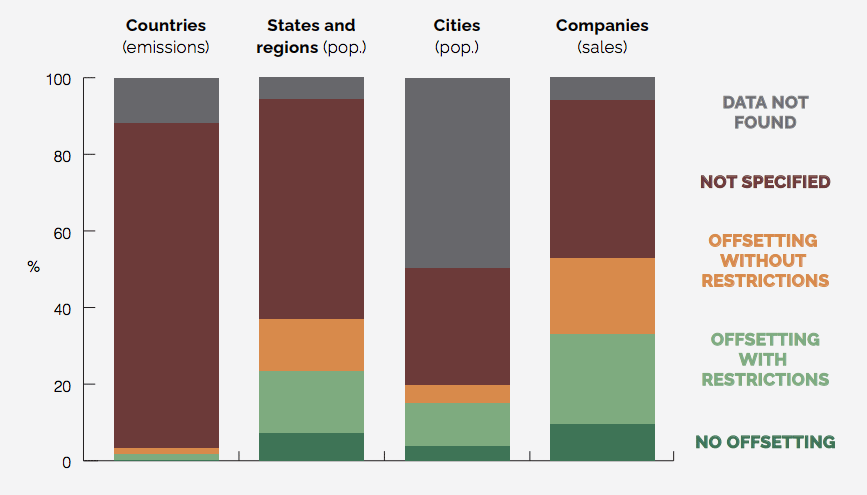
According to a report released in 2020 by a coalition of NGOs, there is “simply not enough available land on the planet to accommodate all of the combined corporate and government ‘net-zero’ plans for offsets and bioenergy with carbon capture and storage (BECCS) tree plantations”.
Nevertheless, with removals of some form required to meet international climate targets, scientists have attempted to establish an equitable way of allocating “fair shares” of carbon removals between nations, based on historical responsibility. As Prof Lavanya Rajamani of the University of Oxford notes:
“The closer we get to 1.5C…the question becomes less about fair shares in terms of greenhouse gas mitigation and more about fair shares in terms of CO2 removal as well.”
One study found that most European countries would be unable to meet their removal targets domestically, meaning they would have to rely on climate finance or offsetting schemes to support removals abroad.
In Carton’s view, a “just approach” to emissions removal will require “democratic institutions taking much larger responsibility in defining the kinds and amounts of removal that we want”:
“You for example can’t leave it up to corporations to define what part of their emissions are ‘unavoidable’ [and] hence needs to be compensated for by removals – there’s an obvious conflict of interest there.”
Just transition
Instead of “false solutions”, climate justice activists want to see solutions to climate change that not only effectively cut emissions but also ensure that no communities are left behind.
This makes a “just transition”, in which workers and their communities are supported in the shift to a low-carbon economy, central to the idea of climate justice.
The concept of just transition, which originated in US labour unions who forged alliances with environmental justice groups in the 1990s, has since become a key part of international climate discussions. The Paris Agreement itself recognises “the imperatives of a just transition of the workforce”.
It has also been embraced at a high level by the likes of the European Commission, which included a just transition fund in its “green deal”, and US president Joe Biden, who has pledged to create 10m “well-paying” clean energy jobs.
(Carbon Brief has a detailed explainer article examining the history of “just transition” – plus case studies of it in action.)
For many, a just future includes a need to provide a clean energy supply for everyone in a world where 13% of the population – nearly all of them in Africa – lack reliable access to electricity.
Some appraisals of “energy justice” argue that a low-carbon transition will not necessarily solve wider issues of social justice and marginalisation.
As one study puts it, the “transition to lower-carbon sources of energy will inevitably produce and, in many cases, perpetuate pre-existing sets of winners and losers”. Examples include land-rights disputes over wind power projects and the potential harm caused by mineral extraction to make solar panels.
One climate-justice response to this is to emphasise a just transition that includes distributed renewable energy and “non-corporate, community-led climate solutions” that recognise the traditional knowledge of Indigenous peoples and local communities.
Besides affecting communities, a similar “winners and losers” dynamic could also play out in how different nations benefit from the clean energy industry.
Dr Stanley Semelane, a senior researcher at the Council for Scientific and Industrial Research (CSIR) in South Africa, a nation with a large coal industry and one of the highest unemployment rates in the world, says he is worried that for many “the energy transition is more important than a just energy transition”. He tells Carbon Brief:
“This means that most countries that have ratified the Paris Agreement…will forge ahead with the adoption of low-carbon technologies, even in circumstances where there are no plans that will guarantee a just energy transition.”
According to Semalane, besides just-transition funds to protect former fossil fuel workers, technology transfer is important to allow local manufacturing of low-carbon technologies in global south nations. Such transfers are often discussed alongside finance during UNFCCC negotiations.
Fossil fuels and “corporate interference”
At the heart of many climate-justice manifestos – from the Bali principles in 2002 to the people’s demands in 2019 – is a simple call to “keep fossil fuels in the ground”.
According to the last UNEP production gap report, nations are currently aiming to produce 120% and 50% more fossil fuels by 2030 than would be consistent with the Paris Agreement’s 1.5C and 2C goals, respectively.
After Covid-19 took a heavy toll on the fossil-fuel industry, the report’s lead author noted that many governments were “doubling down” on the fuels instead of letting struggling projects “die”.
Many have argued that to shift fossil fuel demand in line with climate targets, governments should accelerate the process by prioritising supply-side measures, such as getting rid of fossil fuel subsidies and stopping new extraction permits.
Climate-justice campaigners have also criticised global north countries and the World Bank for their continued financing of fossil-fuel projects, often based in global south nations, even as their own fossil fuel usage declines.
This is why carbon border adjustments of the variety being proposed by the EU, which place taxes on imported goods based on the emissions associated with their production, have been criticised and even labelled a form of “economic imperialism”.
Dr Arvind Ravikumar, director of the sustainable energy development lab at Harrisburg University of Science and Technology, wrote in MIT Technology Review: “To actively promote such fossil-fuel development and then punish developing countries for emissions through carbon border adjustments is, at best, hypocritical. It’s also unjust.”
Campaigners have also criticised the involvement of corporations in the UN climate negotiations and called for accountability for their “decades of misinformation and political interference in climate policy”.
A report from NGO Corporate Accountability in 2017, for example, detailed the ways in which high-emitting industries were seen to be influencing negotiations.
These included shifting the talks towards carbon markets, encouraging private companies’ involvement in the Green Climate Fund and the promotion of “greenwashing” climate-smart agriculture.
Activist groups have called for an end to this “corporate interference” and the introduction of a conflict-of-interest policy that would prevent businesses from influencing COP negotiations.
How does climate change affect people unequally?
The negative impacts of climate change are unequally distributed around the world. A recent study found that low-income countries are the most vulnerable to natural disasters. This is because they face some of the most frequent extremes, have the least resources to adapt to the changes and generally have the most rapidly expanding population.
The study also emphasises the issues of “intergenerational climate justice” – that younger generations are not responsible for the majority of historical emissions, but will face the worst impacts from climate change.
The map below shows the difference in the number of climate-linked extremes that a child born in 2020 will face, compared to the number that someone born in 1960 will face, over their respective lifetimes, under two different emission scenarios.
Multiplication factor of extreme weather events in a world where current nationally determined contributions (NDCs) are met, and a world at 1.5C warming. Dark red shows extreme weather events will be five or more times more likely. Dark blue shows extreme weather events will be five or more times less likely. Note for heatwaves the scale is x10. The designations employed and the presentation of the material on this map do not imply the expression of any opinion whatsoever on the part of Carbon Brief concerning the legal status of any country, territory, city or area or of its authorities, or concerning the delimitation of its frontiers or boundaries. Interactive by Joe Goodman for Carbon Brief using Natural Earth data. Based on findings from Thiery et al (2021).The charity Save the Children has published a report focused on the results of this study, entitled: “Born into the climate crisis: Why we must act now to secure our children’s rights.” It states in its executive summary:
“The children of these low- and middle-income countries will be burdened with the most dangerous impacts of the climate crisis. They have inherited a problem not of their own making.”
The difference in climate impacts between countries can lead to what one paper describes as “a vicious cycle [that] keeps some countries stuck in a disasters-inequality trap”, holding back their development.
While this effect is most obvious when comparing countries to one another, it is also often clear when comparing different socioeconomic groups within countries.
Heat
Possibly the most direct impact of climate change on people is heat stress. As average global temperatures rise, heatwaves are intensifying – and a recent study found that over one-third of heat-related deaths are driven by climate change.
Extreme heat is often exacerbated by increasing humidity. Researchers have found that if a region’s “wet bulb temperature” – a measure incorporating both temperature and humidity – exceeds 35C, the human body is unable to cool itself down through sweating. As such, this threshold is often called the “limit for human adaptability”.
However, warming is not uniform across the planet. Countries near the equator, such as parts of the Middle East and Africa, are at greater risk of exceeding this limit. The extreme heat is made worse by the fact that many countries do not have the infrastructure to deal with extreme temperatures.
For example, in June of this year, the city of Jacobabad in Pakistan reached 52C, pushing it over the 35C wet bulb temperature limit. This made the city one of only two places on earth to have officially passed the threshold. The Daily Telegraph reported that the extreme heat was exacerbated by the lack of wealth and resources in the region:
“Few have any air conditioning, and blackouts mean often there is no mains electricity. The hospital fills with heatstroke cases from those whose livelihoods mean they must venture out. Stretches of the town’s bazaar are dedicated to keeping cool. Shops sell electric fans and low-tech washing machine-sized coolers that emit a refreshing mist. Electric solutions are undermined by frequent power cuts however. In the city centre, residents often lose power for three or four hours, while in more distant areas the gaps are longer.”
In one study, authors used 16 climatic metrics – based on mean daily surface air temperature, relative humidity, solar radiation and wind speed – to determine a global threshold beyond which temperature and humidity becomes “deadly” to humans.
The map below shows the number of days that regions were exposed to deadly heat conditions, as defined by the paper, between 1995 and 2005. It also projects how many days a country is likely to cross the threshold under low (RCP2.6), mid (RCP4.5) and high (RCP8.5) emission scenarios by 2090-2100 – showing that the global south is likely to be more severely impacted by extreme heat in the future than the global north.
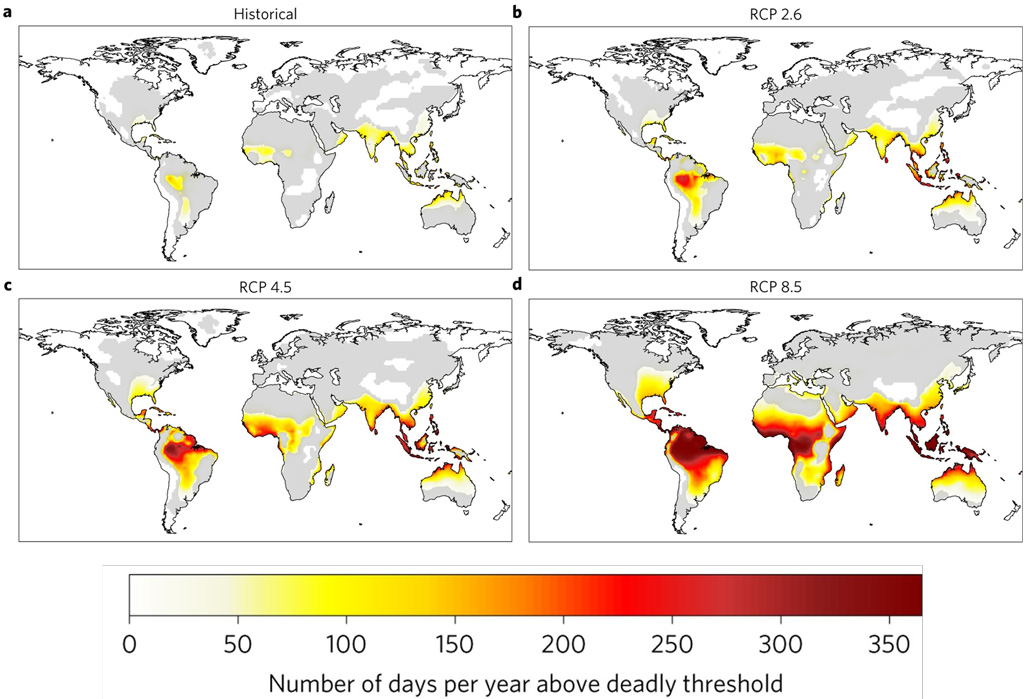
Even when heat does not reach deadly levels, high temperatures can have a range of impacts on human performance – ranging from heat exhaustion to lowering people’s mental health and increasing their aggression levels.
Another study found that warming will drive inequality in economic activity. The optimal average daily temperature for economic activity is 13C, according to the study. The authors found that as the climate warms, countries in the Northern hemisphere will approach this limit, becoming more productive, while those in the South will exceed this limit and become less productive.
Furthermore, geography is not the only factor that determines heat exposure. Studies have shown that the “urban heat island effect” – high temperatures driven by a combination of less vegetation and denser populations, with closely set buildings and lots of dark surfaces – is more prevalent in poorer areas of the US with fewer white residents.
One study finds that in more than 70% of US counties, “neighborhoods with lower-income and higher shares of non-white residents experience significantly more extreme surface urban heat than their wealthier, whiter counterparts”. Another study has found that black people are 52% more likely than white people to live in areas of unnatural “heat risk-related land cover”. Asian people are 32% more likely and Hispanics 21%.
This issue was highlighted recently after the heatwave that struck the US and Canada in 2021, in a Nature news feature entitled: “Racism is magnifying the deadly impact of rising city heat.”
Floods and storms
As the climate warms and sea levels rise, low-lying land is expected to flood more frequently. A recent study found that regions near the tropics will be particularly affected by sea level rise (SLR), concluding that “the burden of current coastal flood risk and future SLR falls disproportionately on tropical regions, especially in Asia”.
The study notes that even if global sea levels rise by only one meter by the end of the century, and population number and distribution do not change in this time, the number of people at risk of flooding will rise from 267 million to 410 million people. It adds that 72% of these people will be in the tropics, with 59% in tropical Asia alone.
The map below shows the number of people who would be at risk from 2m sea level rise, assuming that populations continue to grow and migrate.
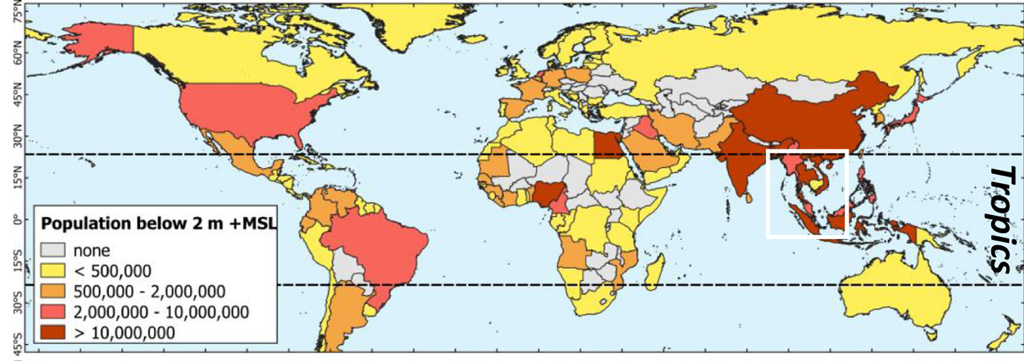
When combining the impacts of various extreme weather events, the tropical region shown in a box in the map above is often highlighted as an area of particular vulnerability.
Every year, non-profit group Germanwatch produces a “Global Climate Risk Index”, analysing to what extent regions have been affected by impacts of weather-related loss events, such as storms, floods and heat waves. The index “quantifies impacts of extreme weather events”, taking fatalities and economic losses into consideration.
The map below shows the results of their most recent study (pdf). “Climate risk index” is mapped for most countries in the world – where a lower score and darker colouring indicates that the country has greater exposure and vulnerability to extremes.
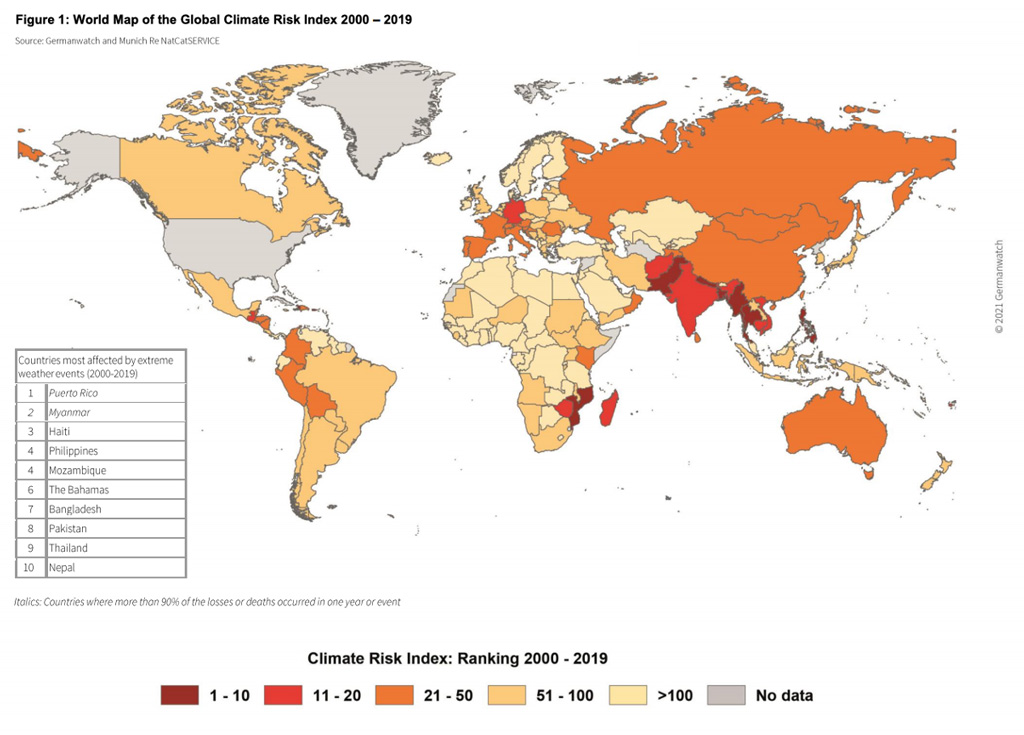
The report highlights the Top 10 most vulnerable and exposed countries, as shown in the table above. It states that the three highest-risk countries – as well as some others further down – are vulnerable mainly due to hurricanes, cyclones and typhoons.
It highlights that, although some countries in the western world are also hit by extreme weather, they generally have more resources to deal with the damage:
“The relative economic losses and the fatalities are usually relatively minor compared to the countries’ populations and economic power due to their coping capacity.”
Migration and conflict
As the climate warms and more regions of the world become inhospitable, impacts including heatwaves, floods and droughts can cause additional stresses, such as water scarcity and food insecurity. In many regions, these changes are already forcing people to leave their homes.
While climate migration can be a problem in both rich and poor countries, poverty is a major driver of people’s vulnerability to climate-related shocks and stressors. As such, climate-related migration is less common in industrialised, urbanised countries than it is in low-income countries with large rural populations.
Science magazine recently ran a special issue on the topic of climate-induced migration, including an editorial that opened with the statement: “Climate-forced population displacement is among the greatest human rights issues of our time.”
A policy forum piece in the special issue focused on Bangladesh as an example. It finds that 4.1 million people were displaced as a result of climate disasters in 2019 – amounting to 2.5% of the total population. Meanwhile, it added that “13.3 million people could be displaced by climate change by 2050, and 18% of its coastland will remain inundated by 2080”.
Migration can be international or internal, meaning migrants who are displaced within their own country. A 2018 World Bank report finds that climate change could drive more than 140 million internal climate migrants by 2050.
However, climate migration is not just an issue in developing countries. One study into coastal migration in the US concluded that “unmitigated sea level rise is expected to reshape the US population distribution, potentially stressing landlocked areas unprepared to accommodate this wave of coastal migrants”.
This also has implications for global security. The United Nations Environment Programme’s website explains that climate change is a “threat multiplier” and can drive increasing conflict. It says:
“Where institutions and governments are unable to manage the stress or absorb the shocks of a changing climate, the risks to the stability of states and societies will increase. Climate change is the ultimate ‘threat multiplier’ aggravating already fragile situations and potentially contributing to further social tensions and upheaval.”
How has climate justice shaped international negotiations?
The struggle for “just” outcomes has played a critical role in shaping international climate negotiations over the past three decades.
When the UNFCCC – the world’s first climate change treaty – was established in 1992, climate-justice principles were at its core, albeit not explicitly described in such terms.
The convention includes a “polluter pays” principle, indicating that richer nations should “take the lead” on climate action. Its opening section (below) also alludes to their “historical and current” responsibility for emissions.

It also refers to “common but differentiated responsibilities and respective capabilities” (CBDR-RC) when it comes to tackling climate change.
CBDR-RC appears in the first paragraph of Article 3 (below), which sets out the “principles” that are meant to guide implementation of the convention. This principle, which enshrines the idea of different responses to climate change from different nations, has provided guidance – and driven disputes – in UN climate talks ever since.

The convention also references providing developing countries with “funding, insurance and the transfer of technology” where necessary.
“The convention was actually a very good starting point,” Meena Raman from Third World Network tells Carbon Brief.
However, as talks progressed towards assigning percentage targets for emissions cuts within set timeframes, climate justice advocates such as Raman felt that the talks were drifting further away from the original vision of the UNFCCC. As Power Shift Africa’s Mohamed Adow tells Carbon Brief:
“We haven’t had a solution which is actually effectively operationalising those principles, where we share effort based on equity, based on historical responsibility, based on the differentiated capability of different countries. That never came about.”
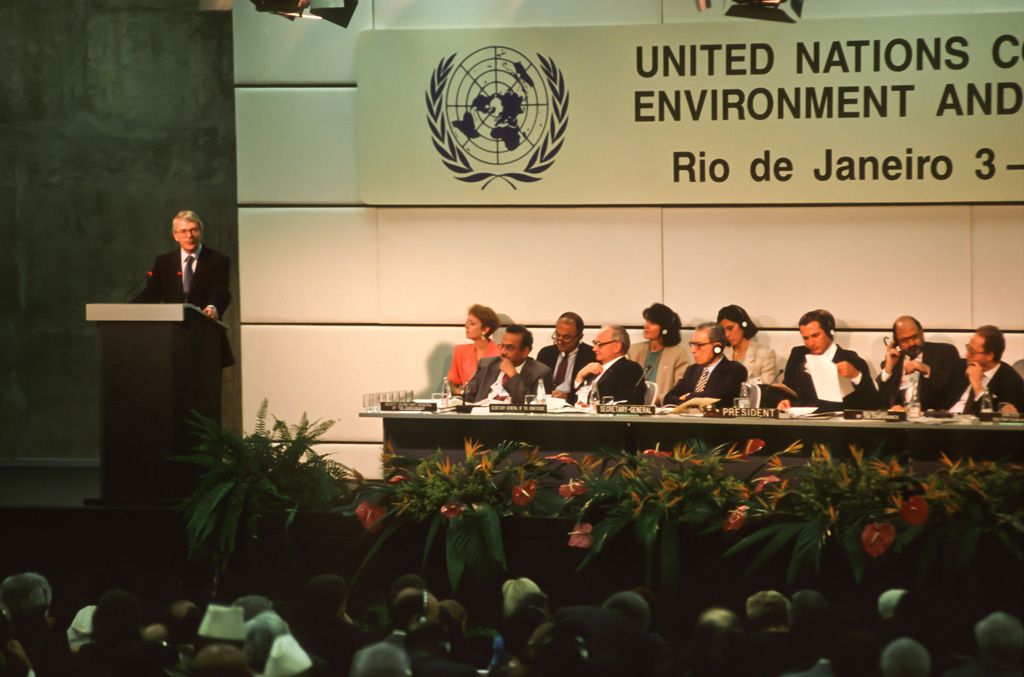
One key issue is that the convention divides nations into clear groups. Annex I consists of industrialised nations that were members of the OECD in 1992, plus countries with “economies in transition”, such as Russia and eastern European states. Annex II only contains the OECD nations, which must provide finance and technology transfer to others.
The least developed countries (LDCs) are given special consideration due to their “limited capacity” to address climate change. Non-Annex I countries are a broad church of “mostly developing” countries, from China to Tuvalu, that are “especially vulnerable to the adverse impacts of climate change”.
This division, which reflects nations as they were in the early 1990s, regardless of their subsequent growth, has been described as the UNFCCC’s “greatest weakness”. Disputes over which members of which groups should be cutting emissions have shaped COPs ever since.
The first major agreement following the convention was the Kyoto Protocol, agreed in 1997, which – in line with the UNFCCC – only required Annex I nations to stick to emissions targets, amounting to a 5% cut in their total emissions between 1990-2012.

Despite the focus on industrialised Annex I nations, Raman says that climate-justice groups were “disappointed” by the Kyoto outcome, given its focus on market-based solutions and the “very low target” set overall for these countries:
“We knew how that was generated: by sitting around a table and just [coming up with] numbers, it wasn’t based on any science really…in terms of what is fair.”
The US ended up refusing to ratify the Kyoto Protocol, due to the lack of binding targets for big emitters, such as China and India. Ultimately, Canada, Japan and Russia did not take part in the protocol’s second commitment period.
As the climate-justice movement grew in the intervening years, there was hope that the COP15 summit in Copenhagen in 2009 would result in a successor agreement to Kyoto that would be fair and equitable for poorer nations.
As demonstrators clashed with police in the streets outside the conference, key groupings of nations were emerging and making their presence felt in the talks, motivated in part by climate-justice principles.
Members of the Bolivarian Alliance for the Americas (ALBA) – which includes Bolivia, Cuba, Ecuador, Nicaragua and Venezuela – had begun pushing for a more human rights-based, anticapitalist vision within the climate negotiations.
Meanwhile, amid growing calls – including from poorer developing countries – for the “large developing countries” to cut emissions, China, India, Brazil and South Africa came together to form the BASIC group.
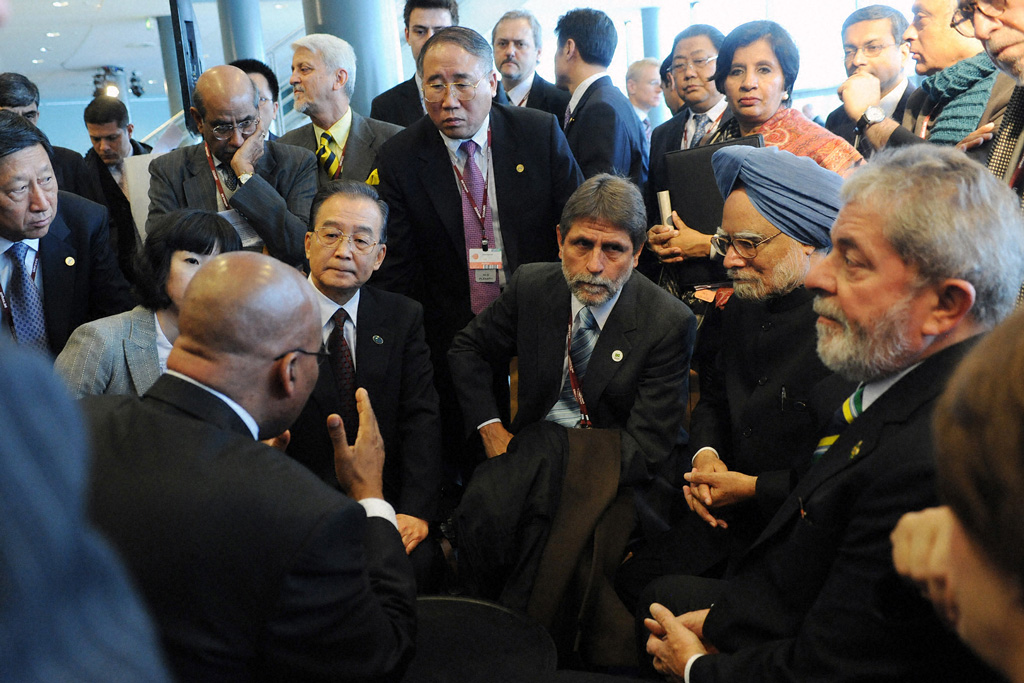
This unexpected alliance has been attributed to shared concerns about a shrinking carbon budget making development harder and a sense that they should not take on the same historical responsibility as industrialised countries.
In the end, the talks were widely seen as a failure after a small group of 25 world leaders led by the US and BASIC nations agreed on a non-binding “Copenhagen accord”, with little input from most of the poorer countries.
This text, ultimately backed by 114 parties, invited all countries – not just the richest – to commit to “nationally appropriate mitigation actions” of their choosing, with Annex I parties required to enhance their Kyoto targets by an unspecified amount.
Despite introducing the idea of a specific 2C warming limit for the first time, the accord was generally seen as step backwards, particularly for the most climate-vulnerable nations, as Bolivian ambassador Pablo Solón Romero wrote in the Guardian at the time:
“Whereas before, under the Kyoto protocol, developed countries were legally bound to reduce greenhouse gas emissions by a certain percentage, now countries can submit whatever targets they want without a binding commitment.”
According to War on Want’s Rehman, the climate-justice movement working alongside sympathetic nations, such as those in the ALBA group, helped to stop this accord from being formally passed, despite mounting pressure from the international community to take action of any kind.
“Without the climate-justice groups we would have had the Copenhagen accord, there is no doubt about it,” he tells Carbon Brief. (As it is, while the accord was backed by many nations it was not formally agreed under the UNFCCC.)
A 2C limit for global warming was not included formally in international climate policy until the Cancun COP in 2010, but by that point it had been discussed for decades and was “recognis[ed]” in the Copenhagen accord text.
Many saw 2C as a “guardrail” to prevent “dangerous” climate change described in the UNFCCC text. However, this was not the case among climate-justice advocates, who for many years had been pushing for a 1C warming limit.
In Copenhagen, Sudanese ambassador Lumumba Di-Aping, chair of the G77 group of developing countries, said that 2C would mean “certain death for Africa”, stating that the deal being offered was a “suicide pact”.
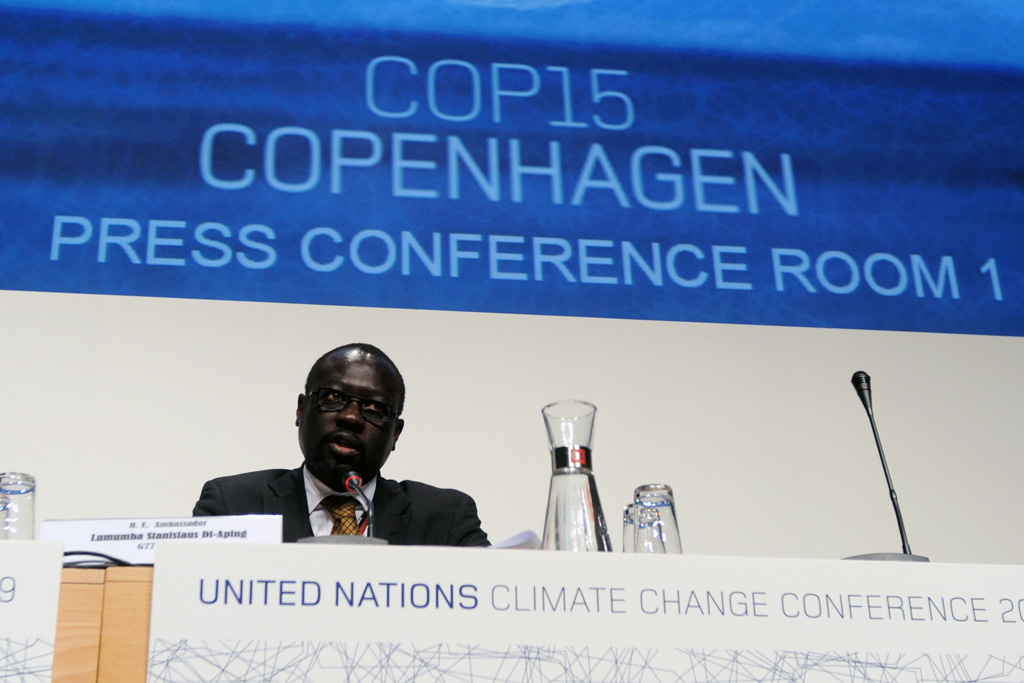
Di-Aping suggested “one Africa, one degree” as a rallying cry. Meanwhile, Tuvalu caused a stir at the event by refusing to engage with talks until a 1.5C target was considered. With the planet passing 1C of warming in 2015, the 1.5C target – which had already been pushed for years by small island nations – became the focus.
Following the disappointment of Copenhagen, then-Bolivian president Evo Morales announced an alternative COP in 2010, dubbed the World People’s Conference on Climate Change and the Rights of Mother Earth, or Cochabamba Conference.
The “people’s agreement” that resulted from this meeting of civil society, Indigenous groups and government representatives has been described as “by far the most comprehensive exposition on rights to be submitted” to the UNFCCC process, with calls for developed countries to provide both financial compensation and restorative justice.
According to one paper: “The ‘people’s agreement’ was all but ignored by the other participants in the UNFCCC. But it did enable the climate-justice movement to formulate key demands and positions.”
At the Durban COP in 2011, nations agreed to forge ahead with a new deal that, unlike Kyoto, would be “applicable to all” nations, both “developing” and “developed”. The EU’s lead negotiator, Elina Bardram, said it “must reflect today’s reality and evolve as the world does”, while US lead negotiator Todd Stern stated their position plainly: “If equity is in, we are out.”
The deadline for a new climate agreement came at COP21 in Paris in 2015. A sign of at least token recognition of justice came in the summit’s opening speech by French president Francois Hollande, who told delegates: “It is in the name of climate justice that we must take action.”
The Paris Agreement that emerged from the summit also included language in its preamble (below) that spoke to the concerns of the climate-justice movement. However, the details of the agreement were more nuanced.

A shift towards a 1.5C target emerged in the lead up to COP21 as higher resolution modelling made the expected impacts on global south nations clearer than before and a “structured expert dialogue” laid out the differences between 1.5C and 2C targets.
Ultimately, advocacy by small island states, “progressive developed and developing nations” in the “high ambition coalition” and supporting civil society groups, saw the 1.5C limit make it into the Paris Agreement as a stretch goal alongside the 2C target.
However, Rehman says there was a “heavy price to pay” for the target, noting the negotiations between US secretary of state John Kerry and small island leaders that saw the removal of language about richer nations providing compensation for loss and damage.
A key contentious point for many observers was the introduction of nationally determined contributions (NDCs), replacing the top-down emissions targets of Kyoto with a bottom-up system where every country sets their own targets, which are not legally binding.
The agreement stresses that these targets would be based on each nation’s “highest possible ambition, reflecting its common but differentiated responsibilities and respective capabilities”, then continues: “in the light of different national circumstances”.
This addition, as well as references to “developed” and “developing” countries rather than the Annexes, emphasises that countries’ responsibilities could evolve over time.
This expectation that all nations – both Annex I and non-Annex I – must come forward with their own climate targets, was seen as a move to “wipe out historical responsibility” so that everybody was at “the same starting point”, according to Raman.
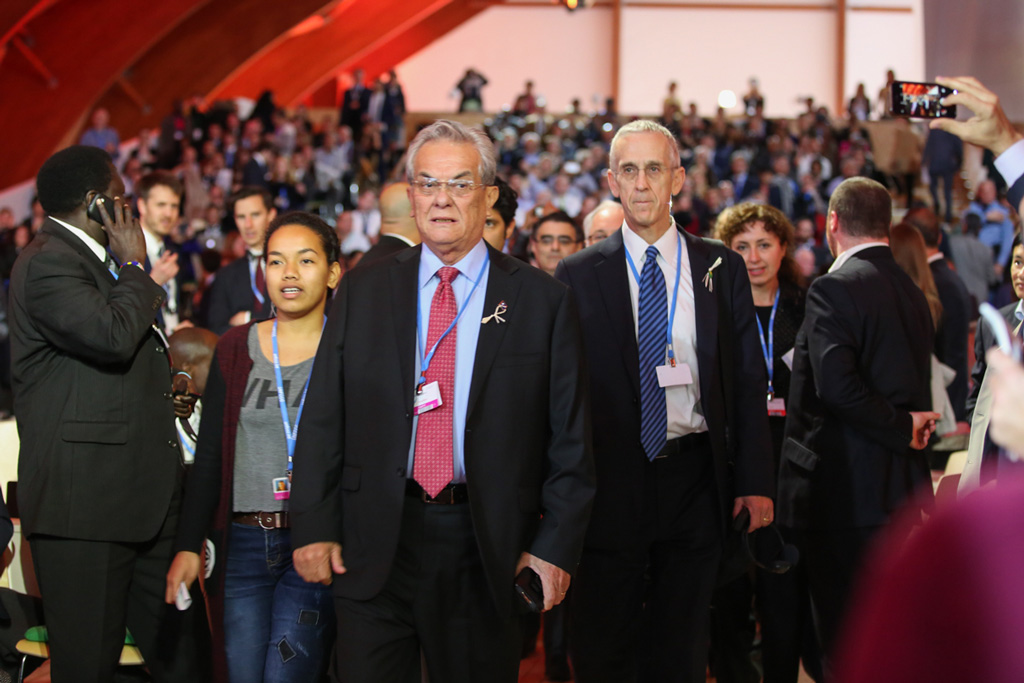
Harjeet Singh from CAN International tells Carbon Brief that, in his view, “NDCs are [the] antithesis [of] climate justice”. He says:
“When you are responding to a global problem, how can you say ‘nationally determined’? You should have been given a quota using science and equity as principles.”
The inclusion of every nation and the lack of legally binding targets were regarded as concessions to ensure US participation. “They didn’t want to go back to their citizens and say ‘you know what, yes, India and China need to reduce their emissions, but we also need to look at our historical responsibility’,” says Singh.
Supporters of the Paris Agreement argue that such concessions were necessary to produce a successful deal. Moreover, former US climate negotiator Todd Stern has written in Brookings that legally binding targets, “paradoxically, can yield weaker action as some countries low-ball their targets for fear of legal liability”.
However, for climate-justice advocates, NDCs have made it even harder to achieve a just outcome from the UNFCCC process. “Using every opportunity to kill common but differentiated responsibility has delayed action,” says Singh.
How has it influenced climate activism and politics?
While climate justice can mean different things to different people, its fingerprints can be seen across the shifting climate change discourse in recent years.
Climate-justice campaigners tell Carbon Brief that for years much of the climate narrative both inside and outside the UNFCCC negotiations was dominated by a focus on melting ice and polar bears.
There was relatively little discussion of who was being affected and who was responsible, they say.
Asad Rehman of War on Want, who was previously head of international climate at Friends of the Earth, says that the overriding narrative among NGOs was that if governments were provided with enough information on climate change they “would act rationally and take action”:
“Climate justice groups were saying: hold on, that’s just not true, because if that was true we would also have solved inequality, poverty and all of these things. You are failing to understand that this is not an environmental issue, it’s fundamentally an economic and political issue.”
Attention shifted more to the people affected by climate change around the turn of the millennium, as the need for adaptation finance rose up the agenda.
Climate justice groups were critical of global north NGOs – organised in the UNFCCC process under the CAN International grouping – for their closeness to developed country governments and particularly their support for market-based solutions to climate change.
Harjeet Singh, currently with CAN International and formerly the climate lead at ActionAid, says global south countries with high emissions such as India and China were used as “punching bags” in climate messaging:
“Organisations from the global north did not show empathy or sympathy with the challenges that developing countries were facing.”
These differences came to a head at COP13 in Bali, when Friends of the Earth International split from CAN and joined with global south organisations to form Climate Justice Now!.
This has since given rise to the Global Campaign to Demand Climate justice, which now forms the other part of the environmental NGO presence at COPs, alongside CAN.
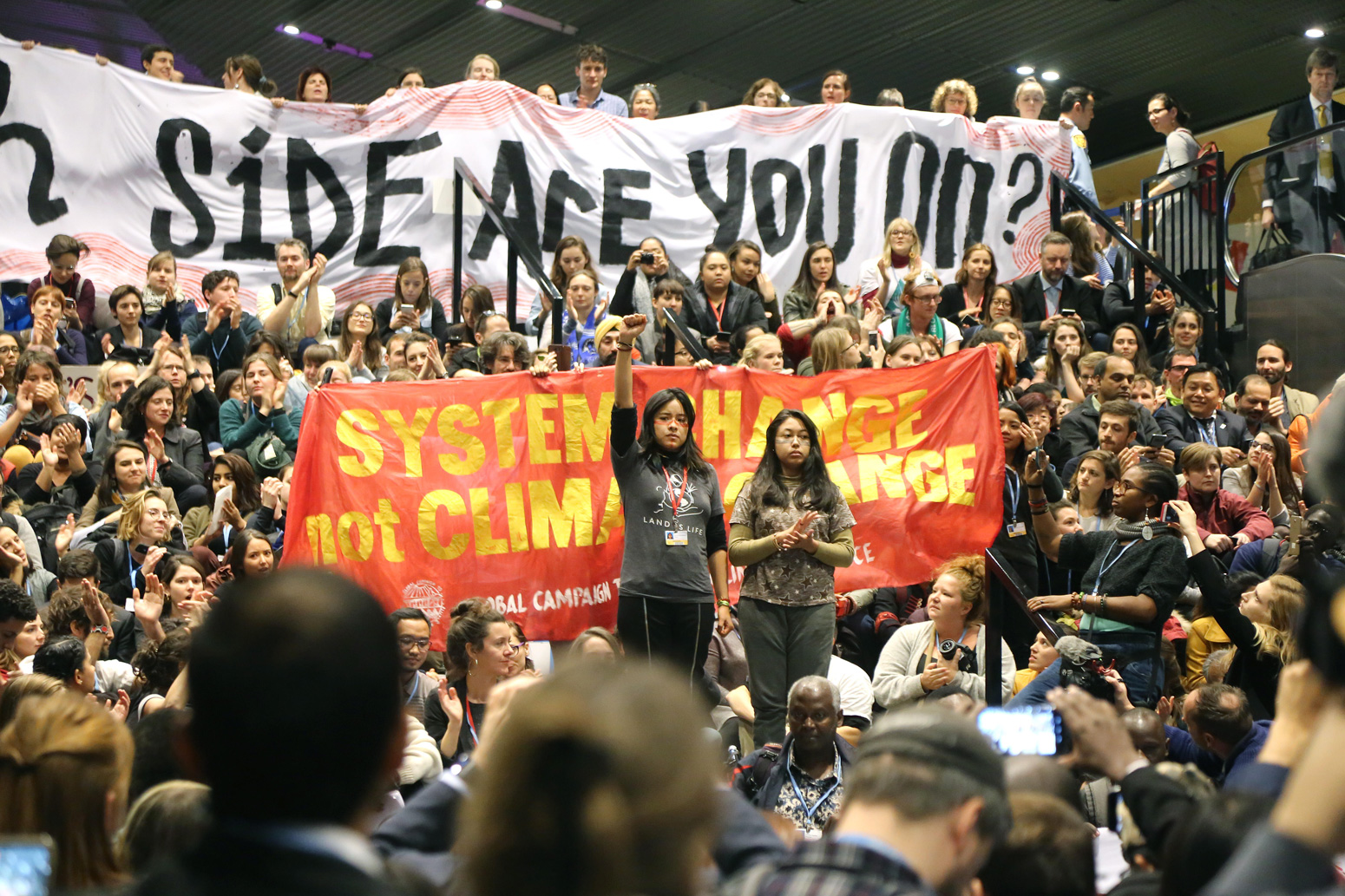
Over the past decade, particularly since the mobilisation around climate justice at COP15 and its failure to secure an agreement, global north NGOs have adopted more justice-oriented messaging. This shift became apparent at COP19 in Warsaw when hundreds of civil society members from around the world staged a mass walkout.
Meanwhile, other groups involved in the climate justice movement have expressed frustration with the UNFCCC process and its ability to achieve “fair” solutions. Some groups, including those protesting oilfields in Nigeria and coal plants in the UK, have turned to direct action “under the loose banner” of climate justice, according to one paper.
Newer protest groups, such as Extinction Rebellion and Fridays for Future, have received criticism from some pre-existing climate-justice campaigners, but have also begun placing climate justice at the heart of their messaging.
The framing of climate justice as a “left-wing” project, which stems from the anticapitalist organisations involved in developing it, has faced backlash.
Upon taking up her post as UK climate minister in 2015, Conservative politician Amber Rudd said she understood why many saw climate action as “cover for anti-growth, anti-capitalist, proto-socialism”.
While some right-wing politicians, in the US and Australia, for example, have used the “socialist” criticism to try and block climate action altogether, figures such as Rudd have instead advocated for their own vision, based on market-based solutions and private industry boosting clean technologies.
Others have argued that tackling climate change cannot be based on socialist perspectives alone and must instead bring in people from across the political spectrum. To this end, Extinction Rebellion has announced it is “not a socialist movement”.
Nevertheless, some elements of climate justice have made their way into mainstream politics, even in staunchly capitalist governments. Notably, for example, climate advocates on the left were credited with pushing US president Joe Biden to adopt a strong focus on ”environmental justice” in his presidential campaign.
Calls for “green new deals”, “just transition” and “green jobs” have all been influential in global north governments in recent years. “This is the language that the movement has been using for a long time,” says Rehman.
While such rhetoric is not necessarily playing out in government actions, Dr Saleemul Huq of ICCCAD says this shift is “a good start”. He adds:
“It’s not enough – but lip service means you have won the argument.”
How has it influenced climate litigation?
The legal system is increasingly being used as a mechanism to seek climate justice.
In recent years, courts have provided a venue for climate migrants, young people and Indigenous groups to challenge corporations and governments, forcing them to take responsibility for their emissions and take on their “fair share” of climate action.
Dr Joana Setzer, a legal specialist at the London School of Economics and Political Science who monitors global progress in climate change litigation, explains its appeal to Carbon Brief:
“Courts have the mandate to consider how action or inaction on climate change affects legally protected interests, such as human rights. In some cases, bringing a court proceeding can allow activists and others to force a debate on how legal obligations to protect those interests should be implemented, even in the face of stagnation or opposition in the political process.”
An early, high-profile piece of climate litigation came in 2005 when Inuit people launched – but ultimately lost – a human rights case against the US, in response to its withdrawal from the Kyoto Protocol.
As the chart below shows, climate-related case numbers have grown considerably since then, with the total more than doubling over the past five years. Most have aimed to enhance climate action, although there have also been a smaller number of “anti-climate” cases.
The vast majority are still in the US and other parts of the global north, but case numbers are also growing in the global south.
According to UNEP, the number of cases will likely keep rising in response to failures by corporations to report climate risks accurately and governments to prepare for climate change.
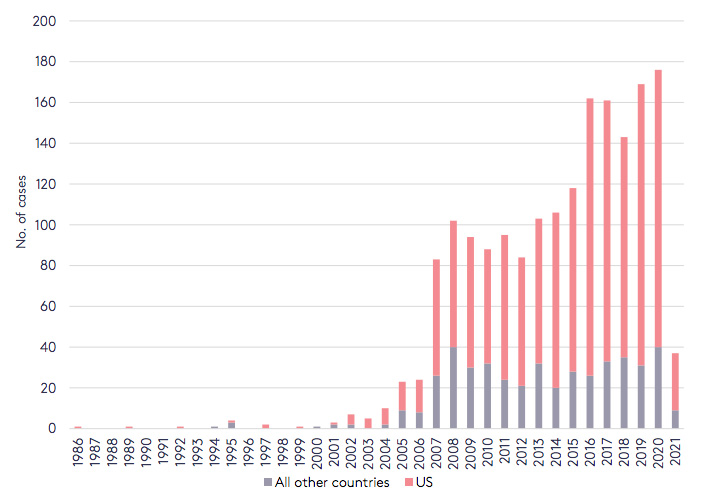
During the first wave of climate cases in the 2000s, which were mainly based on tort and public nuisance actions, plaintiffs struggled to adequately demonstrate why they had a right to bring the case and how they were being affected by climate change.
Increasingly robust climate science, combined with the emerging field of extreme weather attribution, have given litigation a boost in recent years, Lydia Omuko-Jung, a climate change lawyer and research fellow at the University of Graz, tells Carbon Brief.
Another key development has been the so-called “rights turn” in climate litigation. In 2015, a judge in the Lahore High Court, Pakistan, became the first ever to find that the government’s delay in implementing its climate policies violated citizens’ fundamental rights.
More than 100 cases have now been initiated on the basis of climate change breaching human rights and, according to Omuko-Jung, this is a significant development:
“Invoking fundamental human rights and the state’s duty to protect is one of the strategies being used in climate litigation to overcome or get around the restrictive legal standards that have created a challenge in the first wave of climate cases.”
There is evidence that this strategy is working. Both the Netherlands and Pakistan made tangible policy changes as a result of the 2015 rulings. Similar suits have since been filed in nations from Belgium to Brazil.
Moreover, Setzer’s most recent analysis found that of all the cases that had concluded, in a database maintained by the Grantham Research Institute on Climate Change and the Environment, 58% had outcomes they deemed “favourable” to climate action.
There have been a handful of particularly noteworthy cases in recent years, including Neubauer et al vs Germany, in which young people from Germany, Bangladesh and Nepal raised the issue of intergenerational justice.
They argued that the German climate law was insufficient and would result in unfair constraints on young people’s lives, an argument with which the court essentially agreed. The government has since tightened its climate law in accordance with the ruling.
The German case, along with the successful Urgenda vs Netherlands case against the Dutch government and a handful of others have all relied on the idea that nations are not cutting their “fair share” of global emissions and aimed to force them into doing so.
Another recent success for climate justice campaigners was Milieudefensie vs Shell, in which a court ordered the fossil fuel company to significantly reduce its emissions. Setzer explains.
“The court accepted that this would affect Shell’s finances, essentially forcing the company to bear a fair share of the costs of mitigating climate change, to which it has been a major contributor, rather than forcing individuals to bear the costs of ever more severe climate impacts.”
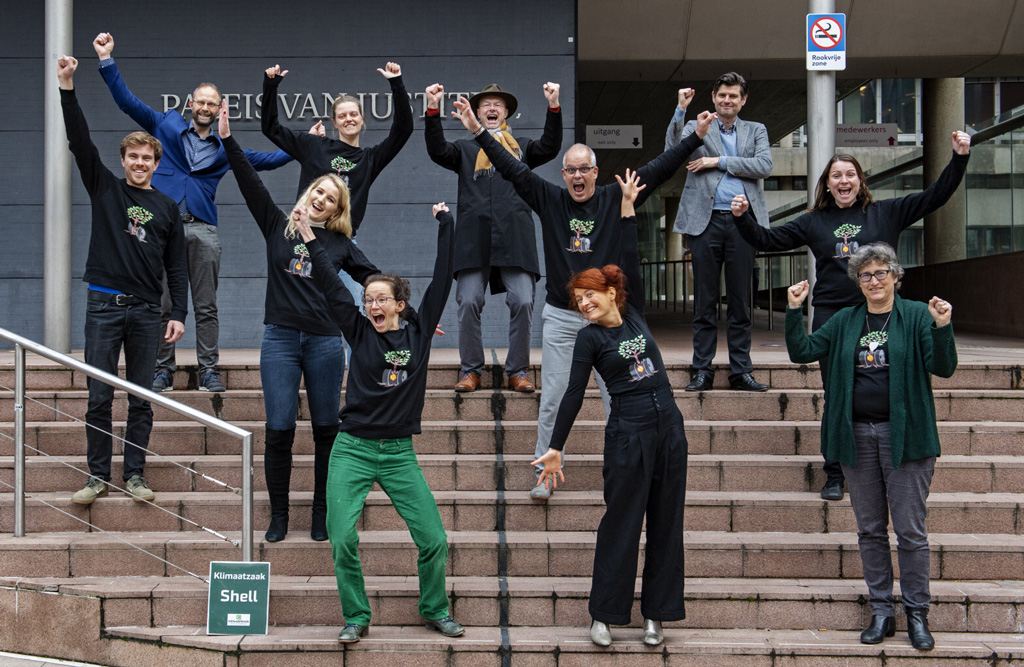
Despite these successes, experts say courts are still not always equipped to address some of the unjust outcomes of climate change.
“Our legal systems are incredibly ill-equipped to deal with climate-induced migration,” Ama Francis, a climate displacement project strategist at the International Refugee Assistance Project tells Carbon Brief.
She notes that there are currently no multilateral treaties or national laws that solely address this issue:
“We need to update our laws in light of the fact that climate change is a defining challenge of the 21st century.”
Some progress was seen in the case of Teitiota vs New Zealand in which Ioane Teitiota, a Pacific Islander from Kiribati, argued, following his denial of refugee status, that climate change had forced him to leave his home.
While the UN Human Rights Committee upheld New Zealand’s decision on grounds that Teitiota was not at imminent risk, it “nonetheless determined that people who flee the effects of climate change and natural disasters should not be returned to their country of origin if essential human rights would be at risk on return”.
Litigation could also develop into a tool for vulnerable states to hold the nations and companies they deem responsible for climate change to account. In 2018, Vanuatu foreign minister Ralph Regenvanu revealed his island nation was considering suing fossil fuel companies.
Omuko-Jung says based on the history of international environmental litigation, such cases filed by nations are unlikely to become prevalent, although it is likely that global south citizens and NGOs will continue the emerging trend of taking big polluters to court.
“Courts are now prepared to take decisions in a way that they may have shied away from a few years ago,” she says.

